

What is Tacking? How to Tack and Commands
The world of sailing is vast and complex, with numerous techniques and concepts to grasp. However, one skill that should not be overlooked is tacking. In this article, we will delve into the intricacies of tacking, providing you with a comprehensive guide on how to tack a sailboat like a seasoned sailor.
Understanding Tacking
What is tacking? Tacking is an maneuver used to change the direction of a sailboat by turning the bow (front) of the boat through the wind. This maneuver allows the boat to sail against the wind, also known as sailing upwind or into the wind.
Whether you choose to tack to the right or the left, the goal remains the same. However, tacking encompasses more than just a simple change in direction. It involves understanding the commands, physics, and dynamics of the maneuver. Let us embark on this journey of knowledge together.
Decoding the Sailing Clock
To grasp the concept of tacking, let’s envision a chalkboard with an arrow pointing downward, representing the wind. Draw a circle on the board, starting from the arrow and encompassing the entire circumference. This circle represents the sailing clock . The zone from midnight to approximately 10 and 2 on either side denotes the upwind sailing area, also known as “no sail zone” According to the laws of physics, sailboats cannot sail directly into this zone. To navigate in that direction, we must employ a technique known as tacking.

Visualize sailing from the 2 o’clock position, 45 degrees off the wind, and gradually turning your boat through midnight on the sailing clock to the other side, beyond 10 o’clock. This zigzag pattern enables you to progress towards your desired upwind destination. Understanding this fundamental concept is the first step toward mastering the art of tacking.
The Mechanics of Tacking
Now that we have established the basic principles, let’s delve into the mechanics of tacking a sailboat. Suppose you are sailing with your sails hauled all the way in, known as “close-hauled,” on a starboard tack (right side facing the bow). To execute a tack successfully, you need to turn your boat 90 degrees and begin sailing on the other side of the sailing clock. Let’s assume you are at the 3 o’clock position and want to reach the 9 o’clock position.
Executing a successful tack requires the boat to maintain enough inertia to sail directly into the wind while maintaining forward progress. This means your boat must have sufficient speed at the start of the maneuver. Through practice and experience, you will develop a sense of the speed required for a seamless tack.

Effective Communication: Tacking Commands
Communication plays a vital role in any sailing endeavor. When executing a tack, clear and concise commands are essential to ensure the coordinated efforts of the crew. Let’s explore the key commands involved in a tack.
- “Ready About”: The helm initiates this command, signaling the crew to prepare for the upcoming tack. The pit crew, located in the cockpit, has crucial tasks such as loading up the lazy jib sheet and preparing to release the working jib sheet. It is important to ensure that the foredeck is clear of any obstacles that may hinder the maneuver. Communicate your intentions to those below deck, as any loose items may fall during the tack. Once everyone is ready, they inform the helm by acknowledging “ready.”
- “Hard-A-Lee”: This command signifies the beginning of the tack. While there are variations of this command, the essential aspect is to turn the helm quickly and decisively. The helm, or the person in charge of steering the boat, turns the tiller or wheel to windward, opposite to the direction of the upcoming tack. This action initiates the turning of the boat and sets the stage for a successful maneuver.
- “Ease the Jib Sheet” : As the boat starts to turn through the wind, the crew in the cockpit releases the working jib sheet, allowing the jib to swing across the boat to the new leeward side. This step is crucial to prevent the jib from backwinding and to facilitate a smooth transition to the new tack.
- “Trim the Jib Sheet” : Once the jib has crossed over, the crew in the cockpit quickly grabs the new working jib sheet and pulls it in to trim the jib for the new tack. This step helps the boat regain power and maintain forward momentum on the new tack.
- “Well Tacked” : This command signifies the completion of the tack and acknowledges that the boat is now sailing on the desired tack. At this point, the crew can resume their normal positions and activities, while remaining vigilant for any further course adjustments or maneuvers.
Mastering these commands and their timing is crucial for a successful tack. Practice and clear communication among the crew will help refine the execution of tacking maneuvers.
Every Sailboat Tacks different
Every sailboat has its own unique characteristics when it comes to tacking. Even for experienced sailors, maneuvering a new boat requires a learning curve, as each vessel responds differently to the wind and helm adjustments. It’s essential not to underestimate the importance of practicing tacks on unfamiliar boats. While some boats may tack smoothly and effortlessly, others present challenges. For instance, catamarans, shoal draft keels, and boats with multiple masts can pose difficulties during tacking.
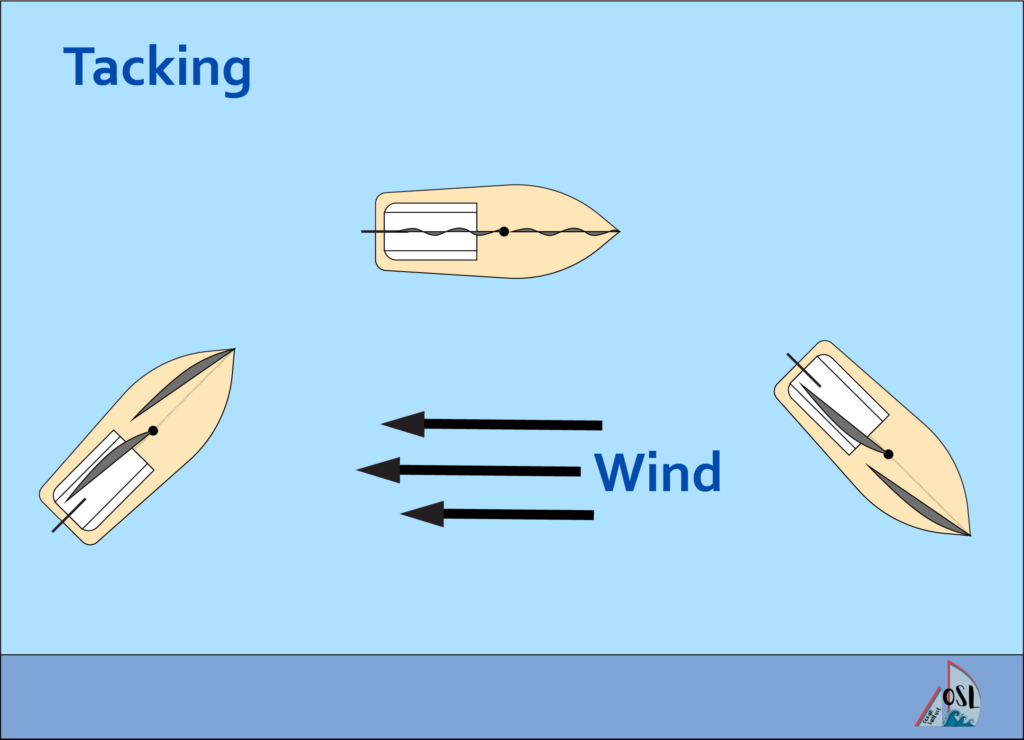
In such cases, a useful technique called “backwinding the jib” can be employed. This involves holding the jib slightly longer on the winch as the boat heads through the wind, allowing the wind to fill the back side of the jib before releasing it onto the new working side. This technique harnesses the wind’s force on the back side of the jib, helping to complete the turn by pushing the bow through the luffing arc. It’s worth experimenting with this method when faced with challenging tacks, while remaining mindful of potential risks to the jib from the spreaders on the mast.
Refining Your Tacking Technique
Tacking is a skill that requires practice, patience, and a deep understanding of your sailboat’s characteristics. Here are some tips to refine your tacking technique:
- Timing is Key A well-timed tack maximizes the boat’s momentum and minimizes the loss of speed. Practice and experiment with different wind conditions to understand the optimal timing for tacking.
- Maintain Boat Speed Before initiating a tack, ensure that your boat has sufficient speed to maintain momentum through the wind. A faster boat will have better steerage and control during the maneuver.
- Minimize Rudder Movements Oversteering or excessive rudder movements can slow down the boat and impede its ability to turn smoothly. Practice using subtle and precise rudder inputs to maintain control and efficiency.
- Communicate Clearly Clear and concise communication is essential during tacking maneuvers. Ensure that everyone on board understands the commands and their respective roles. Use consistent terminology to avoid confusion and maintain a smooth workflow.
- Experiment and Adapt Tacking techniques may vary depending on the type of sailboat and individual preferences. Don’t be afraid to experiment with different approaches and adapt them to suit your specific sailing conditions and boat characteristics. Continuously refine your technique based on what works best for you and your crew.
Remember, mastering the art of tacking takes time and practice. With dedication, experience, and a focus on continuous improvement, you will become proficient in executing smooth and efficient tacks, enhancing your overall sailing skills. Enjoy the process and embrace the challenges as opportunities for growth and learning.
In conclusion, mastering the art of tacking is an essential skill for any sailor. It requires a combination of knowledge, intuition, and experience to effectively navigate through the wind and execute a successful maneuver. By understanding the commands, being aware of the wind’s behavior, and using tools such as a windex or mobile apps, sailors can enhance their ability to “see” the wind and make informed decisions about when to tack.
With practice and determination, sailors can confidently tack their boats, adjusting their course and embracing the challenges that come with sailing. And remember, if all else fails, the trusty motor is there to lend a helping hand. So, set sail, embrace the wind, and let the journey of tacking unfold, for it is a gateway to endless adventures on the open seas.
Similar Posts

The 6 Points of Sail: Diagram of Wind Direction and Sail Trim
Points of sail are the different angles at which a sailboat can sail in relation to the wind. Understanding these points is crucial for anyone who wants to learn how to sail, and it’s usually taught in sailing schools. Each point has its own characteristics that determine the boat’s speed and direction. The main points…

Sailboat Navigation: How to Navigate on Water
Mastering sailboat navigation is of paramount importance for sailors of all levels of experience. Whether you’re a seasoned sailor or a novice setting out on your first boating adventure, having a solid understanding of marine navigation is essential for your safety and confidence on the open waters. By honing your navigational skills, you can ensure…

13 Beginner Sailing Tips: Your Guide to Getting Started
Sailing can be an exhilarating experience, but for beginners, it can also be overwhelming. The thought of controlling a boat while being surrounded by water may seem daunting, but fear not, with the right knowledge and preparation, anyone can learn how to sail. In this article, we will share some beginner sailing tips that will…

Navigating Life’s Storms: 7 Life Lessons from Sailing
Sailing is more than just a hobby; it is a lifestyle that can help you develop a wide range of skills and abilities. Whether you are a seasoned sailor or just starting, the 7 life lessons from sailing can be applied to various aspects of your life, from your personal relationships to your professional endeavors….

How to conduct a safety briefing on a sailing yacht
Sailing is a thrilling and adventurous activity that requires a certain level of knowledge and skill to ensure the safety of the crew and vessel. One of the most critical aspects of sailing is conducting a safety briefing before setting sail. A safety briefing is essential to ensure that all crew members are aware of…

How to Sail Around the World on a Budget
Sailing around the world is a dream for many adventurers, but the idea of circumnavigating the globe can seem daunting, especially when considering the potential costs involved. However, with careful planning, a bit of know-how, and a willingness to live frugally, it’s possible to embark on this adventure without breaking the bank. In this article,…
How To Sail Against The Wind
Sailing against the wind, also known as "beating" or "tacking," can be challenging but it is an important skill for sailors to master.
Being able to sail against the wind means a sailor can sail their boat in most locations in the world.
To sail a sailboat against the wind:
- Check the wind direction
- Tack the boat
- Use the tiller/steering
- Adjust the sails continuously
Following these steps will allow a sailboat to sail windward.
1. Check The Wind Direction
The first step of sailing against the wind direction is the check the exact direction in which the wind is blowing.
To check the direction of the wind:
- Use a wind indicator : Use a wind indicator like an anemometer to measure the exact wind direction
- Check the onboard flag or sails : Look at the sails or flags onboard to get the exact wind direction
- Check the weather forecast : Sailors can check the local weather forecast to get the exact direction the wind is blowing
Sailing against the wind requires a sailor to sail at an angle to the wind so a sailor will need to know the exact direction the wind is coming from to set this angle.
The benefits of checking the wind direction are it will inform the sailor of the exact wind direction so a tacking angle can be set and it will inform the sailor of the wind speed so they will know the force on the sails and keel.
2. Tack The Sailboat
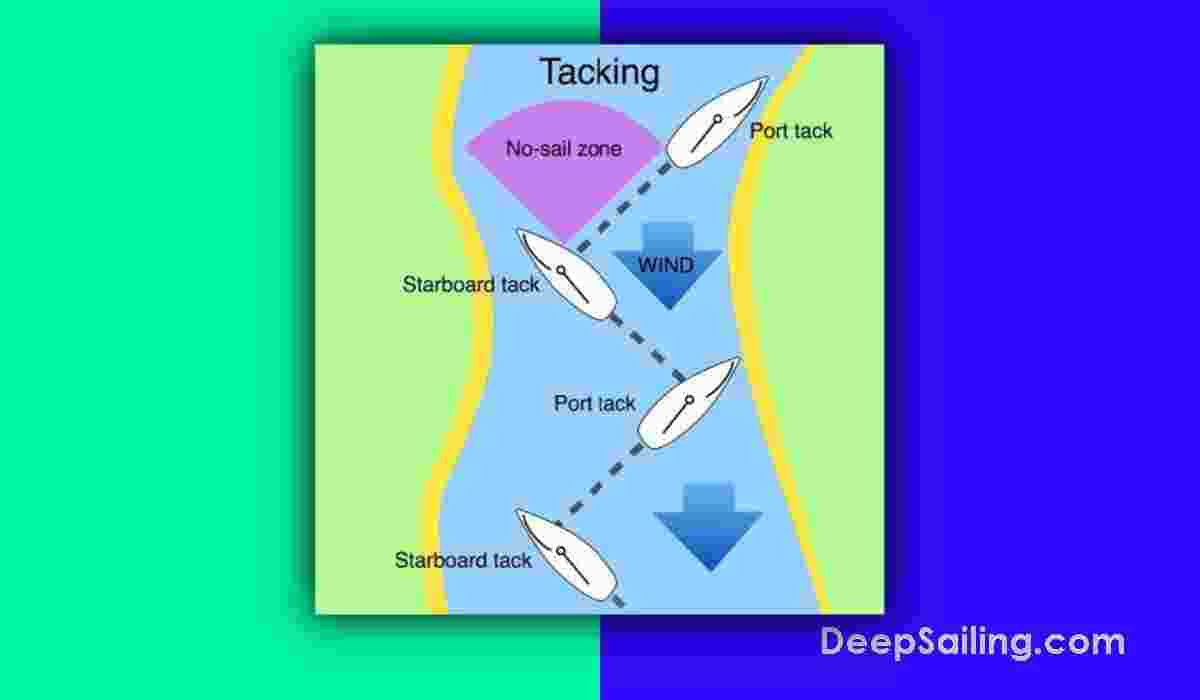
The second step of sailing into the wind is to tack the sailboat, also known as "tacking".
Tacking is a sailing maneuver used to change the direction of a sailboat by turning the bow of the boat through the wind. This is also known as "coming about" or "beating."
When sailing, tacking is used to sail against the wind or to change the direction of the boat when sailing at an angle to the wind.
The tacking sailing maneuver means a sailboat will sail in a zig-zag direction against the wind rather than sailing at a 90-degree angle windward. The zig-zag direction change means the wind will alternate between blowing on the starboard side and blowing on the port side.
For example, if the wind is blowing from the north, tacking would mean sailing the sailboat in the direction between northeast and northwest rather than directly north.
To tack a sailboat:
- Alert the crew : Alert the crew that you're about to tack the sailboat to prepare them to go to a close haul. Close hauled is a sailing term used to describe the point of sail where the boat is sailing as close to the wind as possible. This means that the boat is heading upwind with the sails trimmed in tight and the wind coming from the side of the boat
- Tighten the mainsheet : Tightening the mainsheet is used to adjust the angle of the mainsail in relation to the wind. The mainsheet is the rope that controls the mainsail and it runs from the sail to the aft end of the boat
- Adjust the angle of the sails : Adjust the angle of the sails until the sailboat is sailing at a 45-degree angle against the wind. Sailing at a 45-degree angle to the wind direction will allow the sailboat to sail close-hauled and help it to travel in the direction of the wind without being stopped by the wind forces
The keel of the sailboat will provide stability and prevent the sailboat from capsizing or being blown sideways by the wind. The keel is a heavy, vertical fin-like structure that extends down into the water from the bottom of the sailboat's hull.
As the sailboat moves against the wind through the water at a 45-degree angle, the keel acts as a counterbalance to the force of the wind on the sails, helping to keep the boat upright and on course.
3. Use The Tiller/Steering
The third step of sailing against the wind is to continuously use the tiller/steering on the sailboat. When sailing against the wind, the tiller or steering is an essential tool that the sailor uses to maintain the boat's course and angle to the wind.
Using the tiller/steering system when sailing against the wind will:
- Keep the boat close-hauled : When sailing against the wind, the boat needs to be pointed as close to the wind as possible. This is known as close-hauled sailing. To achieve this, the sailor must use the tiller or steering to keep the boat pointed upwind which helps the boat maintain its course and speed at a 45-degree angle to the wind direction
- Balance the boat : When sailing against the wind, the boat is heeled over to one side as the force of the wind pushes against the sails. The sailor should use the tiller or steering to balance the boat and prevent it from tipping over. This involves making small adjustments to the boat's angle and direction to maintain a stable and controlled sailing posture. The keel will also help with the balance of the boat in the wind
- Maintain forward momentum : Sailing against the wind requires a delicate balance between pointing the boat upwind and maintaining forward momentum. The sailor should use the tiller or steering to maintain the boat's speed and ensure that it is moving steadily forward even when sailing directly into the wind. Getting the right balance between sailing in a zig-zag pattern and maintaining boat speed is crucial
With practice and experience, sailors can become skilled at using the tiller/steering to navigate against the wind and enjoy the unique challenges and rewards of sailing upwind.
When steering the boat against the wind, a sailor should avoid:
- Turning the boat too slowly : When steering the boat against the wind, avoid turning too slowly when tacking as this can cause the sailboat to get caught in irons which can halt any progress when sailing against the wind
- Oversteering : When steering the boat against the wind, avoid steering it too much (oversteering) as this can result in the sailboat not pointing at a 45-degree angle against the wind and instead have the point of sail close reach or broad reach which will halt progress when sailing against the wind
- Tangling the jib sheet : Jib sheets might tangle with some fixtures on the fore deck and will need to be unwrapped. To prevent this from happening, close all fore deck hatches, keep some tension on both jib sheets before and during the tack and clear off any item that may snag the sheets
4. Adjust The Sails Continuously
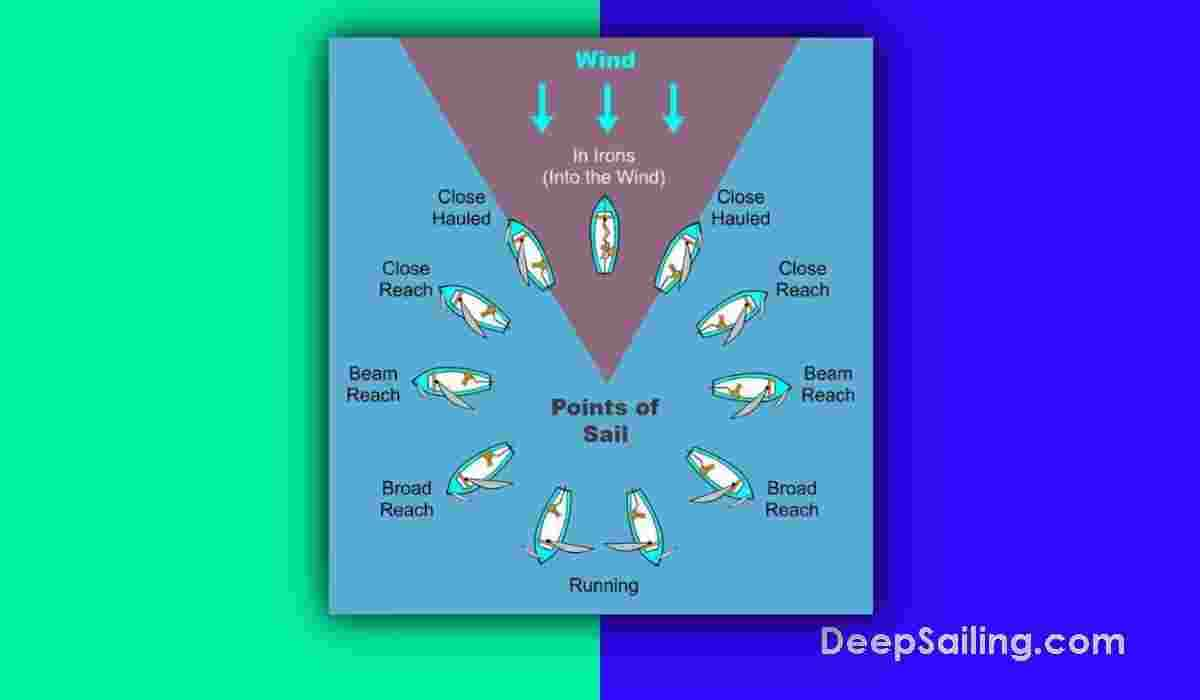
The fourth step of sailing against the wind is to continuously adjust the sails as the sailboat progresses upwind.
To adjust the sails when sailing against the wind:
- Trim the sails : To sail efficiently upwind, the sails need to be trimmed in tight. This means pulling the mainsail in close to the centerline of the boat and tightening the jib sail to bring it as close to the wind as possible. This will help the boat maintain its course and speed and reduce the amount of sideways drift.
- Watch the telltales : The telltales are small strips of ribbon or yarn that are attached to the sails and help the sailor gauge the airflow across the sail. When sailing against the wind, the telltales on the jib sail should be flowing straight back indicating that the sail is at the proper angle to the wind. If the telltales are fluttering or streaming forward, the sail may need to be adjusted
- Use the boom vang : The boom vang is a line that runs from the bottom of the mast to the boom and helps control the shape of the mainsail. When sailing upwind, the boom vang can be tightened to flatten the mainsail and reduce its draft. This can help the boat sail more efficiently and maintain forward momentum
- Adjust the traveler : The traveler is a device that runs across the cockpit or deck and allows the mainsail to be adjusted from side to side. When sailing upwind, the traveler can be moved windward to help keep the boat on course and maintain a balanced sail plan
Overall, adjusting the sails when sailing against the wind is a delicate balance between maximizing efficiency and maintaining control.
With practice and experience, sailors can learn to adjust the sails to suit the prevailing wind conditions and sail upwind with confidence and skill.
Frequently Asked Questions
Below are the most commonly asked questions about sailing against the wind.
How Long Does It Take To Learn How To Sail Against The Wind?
It will take a beginner sailor 3 to 5 attempts to properly sail a sailboat against the wind without any supervision. The timeframe of this is typically within 1 week of practicing 3 to 5 times. However, some sailors may take longer.
What Are The Forces When Sailing Against The Wind?
When sailing against the wind, there are four forces at play:
- Wind Force : The wind is the primary force that is opposing the motion of the sailboat. As the boat sails into the wind, the wind exerts a force on the sails that resists the forward motion of the boat
- Lift Force : The sails generate lift which is a force that propels the boat forward. When sailing against the wind, the lift force is reduced as the sails are not able to generate as much lift as when sailing with the wind
- Resistance Force : As the boat moves through the water, it creates a resistance force which is the force that opposes the forward motion of the boat. This force is influenced by the shape of the hull, the size of the boat, and the speed of the boat
- Friction Force : The friction between the water and the hull of the boat generates a force that opposes the forward motion of the boat. This force increases as the speed of the boat increases
When sailing against the wind, the opposing forces of wind and resistance become more dominant making it more difficult for the boat to move forward.
Sailors use the tacking technique which involves zigzagging back and forth across the wind to make progress against the wind. This allows the boat to use the lift force of the sails more effectively while minimizing the resistance force.
What Are The Benefits Of Sailing Against The Wind?
The benefits of sailing against the wind are:
- Improved sailing skills : Sailing against the wind requires more skill and technique than sailing with the wind. It can be a great way to improve your sailing skills as you learn how to adjust the sails, steer the boat, and navigate more effectively
- Access to more destinations : When sailing with the wind, a sailor's options for destinations may be limited by the wind direction. However, when sailing against the wind, a sailor can access more destinations that may have been previously out of reach
- Greater control : Sailing against the wind requires more attention and focus but it gives a sailor greater control over the boat. A sailor can fine-tune the sails and the boat's position to optimize the speed and direction without issues or limitations
- Challenge and adventure : Sailing against the wind can be a thrilling and adventurous experience. It requires mental and physical toughness and the satisfaction of successfully navigating against the wind can be very rewarding
Overall, while sailing against the wind may require more effort and skill, it can also provide a unique and exciting sailing experience with its own set of rewards.
What Are The Risks Of Sailing Against The Wind?
The risks of sailing against the wind are:
- Increased risk of capsizing : When sailing against the wind, the boat may be more prone to capsizing due to the combination of wind and waves. The boat may be more difficult to control in these conditions and sailors will need to be prepared for any issues with the sailboat capsizing
- Fatigue and physical strain : Sailing against the wind requires more physical effort and can be more tiring than sailing with the wind. This can lead to fatigue and physical strain which can affect a sailor's ability to navigate safely
- Navigation challenges : Sailing against the wind may require more careful navigation and planning as sailor may need to navigate around obstacles and adjust their course more frequently. This can be challenging especially in unfamiliar waters or adverse weather conditions
- Increased wear and tear on equipment : Sailing against the wind can be more taxing on the sailboat equipment as the sails and rigging are subject to greater stress, force, and strain. This can increase the risk of equipment failure or damage
To mitigate these risks, it is important to be prepared and to have the proper training and experience to handle sailing against the wind. This includes ensuring that the sailboat and equipment are in good condition, understanding the weather and navigation conditions, and taking appropriate safety precautions. It is also important to stay alert and attentive while sailing and to make adjustments as needed to ensure safe navigation.
What Should Be Avoided When Sailing Against The Wind?
When sailing against the wind, sailors should avoid:
- Pinching : Pinching is a term used in sailing to describe the act of sailing too close to the wind. When sailing against the wind, the boat needs to sail at a 45-degree angle to the wind to maintain forward momentum and speed. Sailors should avoid pinching when sailing against the wind
- Sailing in irons : Sailing in irons is when a sailboat is sailing directly against the wind. This will prevent the boat from moving forward against the wind and instead the sail angle will need to be adjusted to close haul to progress further
- Turning too slowly or oversteering : When sailing upwind, avoid turning the sailboat too slow or oversteering it as this can affect the ability of the boat to travel against the wind effectively
How Do Sailboats Travel Against the Wind?
Imagine gliding across the water on a sailboat, the wind whipping through your hair. But wait, isn’t the wind supposed to push you only in the direction it’s blowing? Surprisingly, sailboats can efficiently travel at an angle against the wind, a feat that often baffles onlookers. This seemingly magical ability hinges on two key concepts: aerodynamics (how air interacts with the sails) and hydrodynamics (how water interacts with the boat’s hull).
Understanding the Wind and Sails
Sails aren’t just billowing fabric; they act like airplane wings. As the wind flows over the curved sail, it creates lift , a force that pushes the sail upwards. This lift isn’t perfectly vertical, though. There’s also a forward-directed component that pulls the boat in that direction. However, a sailboat can’t sail directly into the wind. There’s a “no-go zone” of about 45 degrees on either side of the wind where the sail loses its effectiveness.
The Art of Tacking: Zigzagging to Success
So, how do sailboats travel against the wind? They employ a clever maneuver called tacking . Here’s the breakdown:
- Setting the Sails: The sails are angled at an appropriate “close-hauled” position, which is as close to the wind as possible without entering the no-go zone.
- Turning Upwind: The sailor steers the boat towards the wind until it nearly enters the no-go zone.
- Shifting Sails: At this point, a critical maneuver occurs. The sails are shifted (tacked) to the other side of the boat. This involves briefly turning the boat through the wind while adjusting the sails to catch the wind on the opposite side.
- Repeating the Cycle: Once the sails are adjusted, the boat continues sailing at an angle on the other side of the wind.
This tacking process creates a zigzag pattern as the boat sails back and forth, gradually progressing closer to its upwind destination. While it may seem less direct than sailing with the wind, tacking allows sailboats to travel efficiently in any direction, even against the wind.
The Keel’s Role: Countering the Sideways Push
The magic of sailing against the wind isn’t just about the sails. The keel , a deep fin extending below the boat’s hull, plays a vital role. As the wind pushes the sail sideways, the keel acts like an underwater rudder. It pushes against the water, counteracting the sideways force and propelling the boat forward along its zigzag path.
Additional Factors Affecting Upwind Sailing
- Sail Design: Different sail shapes and sizes are better suited for sailing upwind or downwind. Upwind sails are typically smaller and more pointed to optimize lift at close angles.
- Boat Design: The overall design of the boat, including its hull shape and keel depth, also influences its ability to sail upwind effectively.
Sailing against the wind is a testament to the ingenuity of sailboat design. By harnessing the power of aerodynamics and hydrodynamics , sailboats can leverage the wind to travel in any direction, making them remarkably versatile vessels. So, the next time you see a sailboat seemingly defying the wind, remember the science and skill behind the impressive feat of tacking!
Happy Boating!
Share How Do Sailboats Travel Against the Wind? with your friends and leave a comment below with your thoughts.
Read Pickle Fork Boats for Sale: Slice Through the Water until we meet in the next article.
Similar Posts
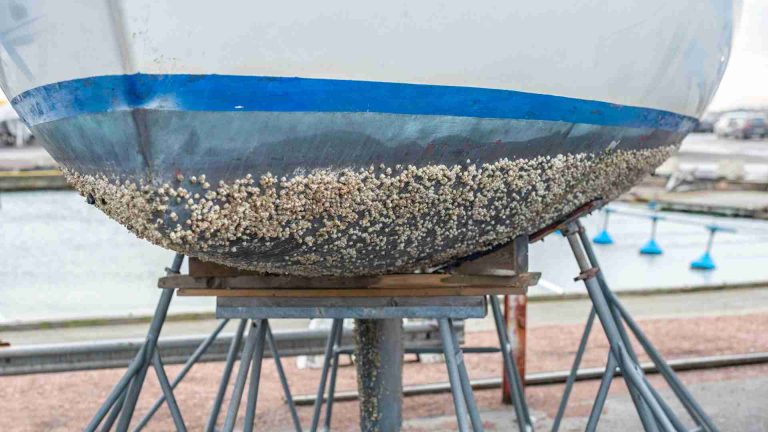
How to Prevent and Remove Barnacles from Boat Hull?
As the gentle waves embrace the hull of your boat, a hidden adversary lurks beneath—the relentless growth of barnacles. This common challenge has plagued boaters for centuries, leaving its mark not only on the vessel’s appearance but also on its performance and fuel efficiency. What Barnacles Are and How They Attach Themselves to Boat Hulls?…

Are Tidewater Boats Reliable and Good? (Review)
In the vast expanse of the boating world, a beacon of excellence shines brightly – Tidewater Boats. With a reputation that sails ahead, Tidewater has established itself as a name synonymous with quality and innovation. As you set your sights on the horizon of boating possibilities, this comprehensive guide unveils the essence of Tidewater Boats…

5 Symptoms to Detect a Bad Primer Bulb on an Outboard
Ah, the trusty primer bulb. That squishy little friend on your outboard engine, often taken for granted until it betrays us with a sputter and a cough. But fear not, captains! Learning to recognize the symptoms of a bad primer bulb can keep you from getting stranded at the dock, and back out on the…

Boat Dealers in Eau Claire Wisconsin: Guide
Eau Claire, Wisconsin, with its stunning lakes and rivers, is a haven for boaters. Whether you’re a seasoned angler seeking the perfect fishing vessel or a family looking for a pontoon boat for leisurely cruising, finding the right dealer is crucial for a smooth and successful boating experience. This guide delves into the world of…
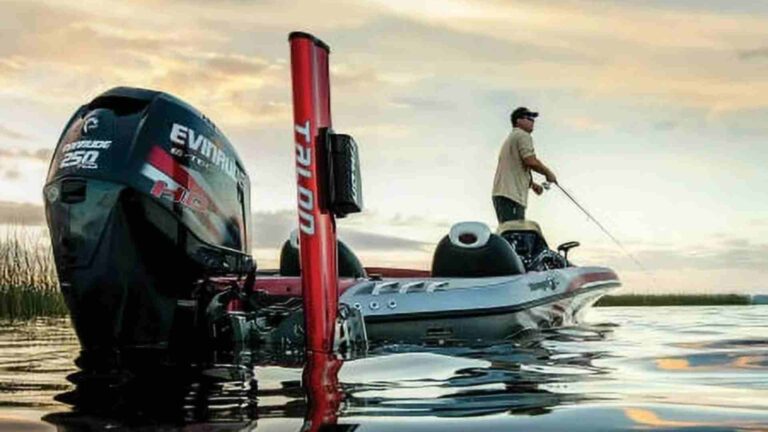
5 Most Common Problems with Minn Kota Talon
Minn Kota Talons, with their rugged design and anchor-like hold, have revolutionized shallow water anchoring for countless anglers and boaters. But even the most dependable equipment encounters snags. So, before venturing into the shallows, let’s dive into the depths of common Minn Kota Talon problems and explore effective solutions: 1. Deployment Difficulties: 2. Retraction Ruckus:…
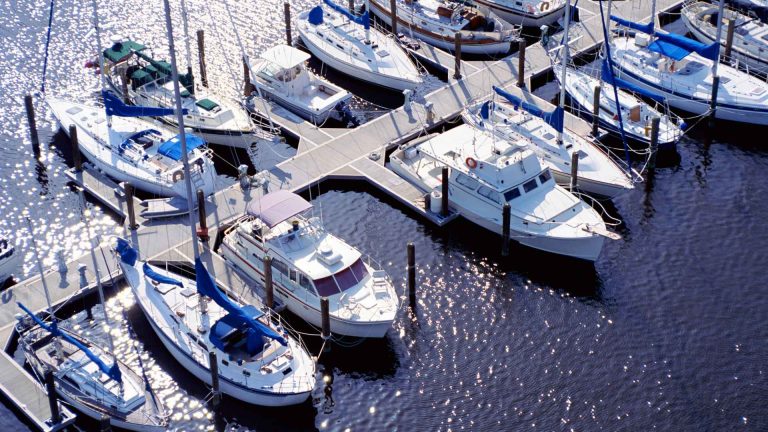
What Is a Boat Slip? Understanding the Basics and Benefits
As the sun glistens on the water, boat owners and enthusiasts alike find solace in the embrace of the open sea. But before setting sail, they require a safe haven for their beloved vessels. This is where boat slips come into play. Boat slips provide a secure and convenient space for boat owners to dock…

- Repeated Customers
- Booking Request
From the wind's embrace to the dance with the waves, we dive into the heart of sailing techniques.
Whether you're a seasoned sailor or a novice, mastering these maneuvers is essential for navigating the seas.
You'll use the Tacking maneuver frequently when sailing against the wind , requiring a series of zigzags against the wind direction to reach your destination.
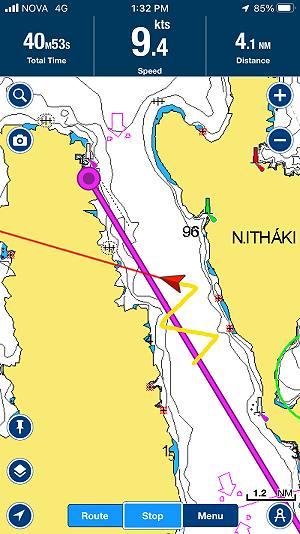
The Tacking Process involves teamwork.
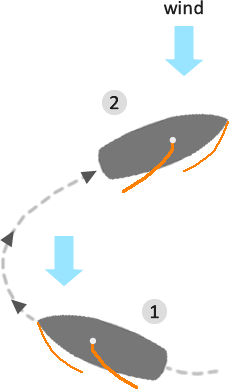
1️⃣ One person sits beside each jib winch .
2️⃣ The helmsman calls " Ready about !" and, upon hearing " Ready " from the winch crew, shouts " Lee Ho !" ... and turns the wheel sharply towards the wind.
3️⃣ Simultaneously, the person on the leeward jib sheet quickly releases it from the winch.
4️⃣ The sails start to flap.
5️⃣ The person on the opposite side rapidly hauls the jib sheet , putting turns on the winch to tighten it.
The mainsail typically tacks itself, positioning on the other side as in the last tack.
It's crucial to be swift as sails could flap, leading to a state called ' in stays ' where the boat is essentially stuck .
Escaping 'stays' can be tricky— try sailing backward or use the engine.
In strong winds , ropes may thrash about, posing potential danger. Always be cautious!
Jybing is turning the boat through the wind while sailing downwind.
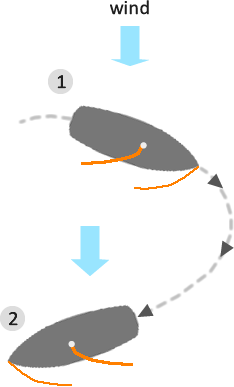
Safety is crucial, as a careless jybe can lead to injuries or even someone going overboard .
1️⃣ The helmsman manages the mainsail .
Firstly, they pull it towards the middle of the boat while turning the boat downwind.
2️⃣ Simultaneously, the person on the leeward jib sheet releases the jib (remembering to keep fingers away from the winch).
3️⃣ At this point, the sails will swiftly cross the deck, with a loud crash.
4️⃣ The person on the newly leeward jib sheet quickly tightens the sail, ensuring the jib sheet is entirely off the winch.
Failing to do this might result in a ' broach ', tipping the boat to its side.
Any loose items will go flying, and your crewmates will be well aware of the chaos.
5️⃣ The helmsman eases the mainsheet swiftly to set the sail for the desired course.
If sailing straight downwind on a 'dead run,' there's a risk of an accidental gybe, known as a " Chinese gybe " or " crash gybe ".
Everything goes flying, and recovery takes a few minutes.
The immediate action is to release the windward jib sheet, turn into the wind gently to stop the boat, gather everything, avoid any upset crew members, and resume sailing.
Tacking and Jibing
Published by admin on may 27, 2019 may 27, 2019.
As we’ve seen, a sailboat cannot sail directly into the wind. The “no-go” zone covers approximately 45° on either side of the wind, so how does a sailboat move toward a desired point that is located upwind? The answer is by tacking back and forth on a zigzag-like path.
While the tack of a boat refers to its direction with respect to the wind, tacking refers to the action of turning into the wind so that the bow of the boat passes through the wind. With such an action, the sails are “flipped” to the opposite side and the boat assumes a tack on the other side of the wind. For example, a boat tacks from a close-hauled starboard tack to a close-hauled port tack. Note that the word tack is used to describe both the heading and the action of turning.
A sailboat can also turn so that the stern of the boat passes through the wind. This action is known as a jibe . The boom and sails are flipped to the other side of the boat for both a tack and a jibe, but the distinction is whether the boat is turning into or away from the wind.
Although tacking and jibing may seem like the same thing, there are some key differences that need to be kept in mind.
First, the sails, and the boom are much further extended during a typical jibe than a typical tack. Although it is possible – and sometimes advisable – to tack from a port broad reach to a starboard broad reach by tacking 300° into the wind, most often such a turn is accomplished by jibing 60° away from the wind. Conversely, it is possible to jibe between close-hauled tacks, but there is no reason to ever do so intentionally. The sheeting angle is larger on downwind points of sail, the only circumstances for a jibe, so the boom travels a much further distance relative to the boat during a jibe than a tack. This difference can easily be seen by comparing the sheeting angles (the angle between the sails and the boat) in the illustrations below.
Second, the boom swings much more rapidly during a jibe than a tack. Notice from the figures that a tacking boat passes through the no-go zone, causing the sails to luff as the boat turns. The wind gradually fills the sails as the boat comes out of the tack. On the other hand, during a jibe, with the wind coming from behind the boat, the boat does not pass through the no-go zone, and the wind pushes the sails from fully extended on one side of the boat to fully extended on the other side of the boat nearly instantaneously. In fact, the wind can so easily change sides of the sail when the boat is pointing downwind, a jibe can even accidentally on runs.
These two factors, the distance and the rapidity of boom travel add up to a jibe being much more violent than a tack. This can be dangerous to the boat, and more importantly to the people aboard. Large forces created by the boom swing can cause wear and tear on the mast and rigging, and can also cause injury – potentially severe – if the boom comes in contact with someone’s head. For this reason, the danger to the boat and crew, some charter companies forbid running, and you also might consider a similar moratorium on downwind sailing in high winds.
Tacking Procedure
Now that we’ve described tacking and jibing, we’ll cover the actual procedure of each. The figure below gives the procedure for executing a tack. Note that the steps are described in terms of the captain’s actions and those of the crew. On a single-manned sailboat, obviously, the captain would have to also carry out the crew’s actions, and the communications wouldn’t be necessary.
First, the captain announces the intention to tack by calling out “prepare to come about,” or “ready about?” The crew then prepares for the tack by uncleating – but not releasing – the active jib sheet. The sheet is held in place by hand, and kept wrapped on the winch if one is being used. If there are enough crew, one person can get in position on the opposite side of the boat near the other jib sheet. Once in position and prepared, the crew lets the captain know by calling out “ready about,” or “ready.”
Next, the captain shifts the rudder or wheel hard to turn the boat across the wind towards the opposite tack, while announcing, “coming about” or “helm is alee.” As the bow turns, the jib luffs and the crew releases the active jib sheet by simply letting go or calmly unwrapping it from the winch.
While the jib is still luffing, the crew sets the opposite jib sheet – wrapping it around the winch if one is used – and cleats it.
After the boat has reached the desired heading, the mainsail and jib can be trimmed further. The crew can make any remaining adjustments to the jib sheet and the traveler can be adjusted for the mainsail. Notice that no adjustments to the mainsheet are necessary for a simple tack to the opposite point of sail.
There are a couple things that can go wrong with a tack, both relating to working the jib sheets. If the active jib sheet is released too soon, the boat will lose power and may not have enough momentum to make it through the entire turn. Since the boat is turning through the no-go zone, momentum is critical for maintaining headway and steerage. If the jib sheet is released too soon, or the turn is not sharp enough, the boat can end up in irons.
Another possibility is that the opposite jib sheet is not set quickly enough by the crew. If the jib sheet is not set while the jib is luffing, it can become difficult to bring in the sheet with the sail full of wind. In this case, the captain can turn back into the wind slightly, allowing the jib to luff and making it easier for crew to work the sheets. Just be sure not to turn too far back into the wind and end up in irons.

Jibing Procedure
The jibing procedure is similar to a tack. The main difference is that the mainsail is the focus of a jibe while the jib is the focus of a tack. To reduce the danger of the boom swinging across the boat, the mainsheet is brought in as the boat turns and then let out after the wind fills the sail on the other side. This reduces the boom travel at the moment that the wind switches from one side of the sail to the other, which greatly reduces danger.
The captain announces the intention to jibe by asking the crew to “prepare to jibe.” The crew then responds by getting in position to work the mainsheet and announcing “ready to jibe.”
The captain then begins to turn the boat – more gradually than during a tack – announcing “jibe ho” or “helm is aweather.” The crew must then bring in the mainsheet as the boat begins to turn.
Once the boom swings across the boat – hopefully not very far since the mainsheet has been brought in – the crew begins to let out the mainsheet. When the jibe is complete, the crew can set the jib and make any remaining adjustments to the mainsheet and traveler.
Notice that the jib is not adjusted until the end of the jibe. Since the boat is not turning through the no-go zone as in a tack, there is no need to worry about losing momentum. The main concern is the danger of the boom swing. In racing situations or when more crew hands are available, the jib can be worked during the turn, but it’s not necessary for making the turn.

Preventing an Accidental Jibe
The potential danger of an accidental jibe, as mentioned earlier, can be reduced by avoiding sailing directly downwind on a run. Another rule of thumb involves monitoring the angle between the bottom of the jib and the horizon. When the bottom of the jib falls so this angle is less than 45°, it’s an indication that you may be getting too close to a run and an accidental jibe is possible. Adjust by heading up a bit towards a broad reach point of sail.
Related Content
Related posts.

Cruising Education
Troubleshooting marine outboard engines.
We've all been there. Eager to jump in the dinghy and land on shore after laying anchor on the mothership. Just one problem, the dinghy outboard wort start.

Education Safety Sailing Basics
Servicing type v personal flotation devices (pfds).
If you're like a lot of recreational boaters, you may not pay a much attention to your life vest. You might not even know what PFD stands for - Personal Floatation Device. You may have even purchased a type V PFD with your #1 criteria being comfort. You throw it on each time you go out, mainly just to make a show of it, and take it off as soon as you're outside the marina - confident that you'll remember to put it back on if the weather picks up.

Best Coffee Brewing Methods for Cruising Sailors
Coffee is life. If you’re like me, you need your cup of joe first thing every morning. There is nothing quite like a great cup of coffee onboard as the sun comes up over your Read more…
How Do Sailboats Sail into the Wind?
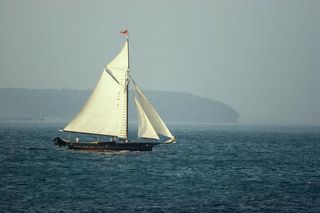
It seems intuitive that sailboats, powered only by the wind, can travel easily with the wind at their backs, but it may seem impossible that they turn around and come home again, with the wind blowing straight against them.
But this reverse movement is possible because a moving boat's sail is shaped as an airfoil like the wing of a plane. When air moves over a plane's wing, from front to back, wind flowing over the top of the wing has to travel farther than wind flowing under the wing's bottom surface. This creates a pressure difference that lifts the plane.
On a sailboat, wind blowing against the boat at an angle inflates the sail, and it forms a similar foil shape, creating a difference in pressure that pushes the sail perpendicular to the wind direction.
According to "The Physics of Sailing Explained" (Sheridan House Inc, 2003), by Kent State University physics professor Bryon D. Anderson, this force from the sail's foil shape is combined with and balanced by other forces, including those of the boat's keel (the long thin piece that juts down from the bottom of the boat).
Together, the forces of drag, from the water, and the pressure from the wind against the sail itself push the craft forward. It moves at an angle opposite the direction of the wind, called windward in sailing terminology.
According to the American Institute of Physics' Physics Today magazine, the keel is especially important because without its balancing action, a boat would simply drift downwind.
Windward sailing also does not work if a boat is pointed directly opposite the wind direction, according to The Physics of Sailing. Wind has to be moving against the boat at an angle of at least 40 degrees for most vessels. Angling too sharply into the wind causes the forces on the boat to become unbalanced, and moves the boat sideways in the water.
Sign up for the Live Science daily newsletter now
Get the world’s most fascinating discoveries delivered straight to your inbox.
A sailor intending to travel windward toward a point exactly in line with the direction of the wind will have to zig zag back and forth to reach its target. Using this "tacking" technique, and traveling at an angle as close to the wind's direction as possible, sailors can reach a point in any direction, regardless of the direction of wind.
Got a question? Email it to Life's Little Mysteries and we'll try to answer it. Due to the volume of questions, we unfortunately can't reply individually, but we will publish answers to the most intriguing questions, so check back soon.
Ancient viral genomes plucked from glaciers reveal how pathogens have adapted to Earth's shifting climate
Large patch of the Atlantic Ocean near the equator has been cooling at record speeds — and scientists can't figure out why
Arctic expedition uncovers deep-sea microbes that may harbor the next generation of antibiotics
Most Popular
- 2 SpaceX Falcon 9 rocket grounded for 2nd time in 2 months following explosive landing failure
- 3 Ancient Egyptians used so much copper, they polluted the harbor near the pyramids, study finds
- 4 James Webb telescope spots 6 enormous 'rogue planets' tumbling through space without a star
- 5 T. rex relative with giant, protruding eyebrows discovered in Kyrgyzstan
Tacking vs Jibing: Understanding the Key Differences
by Emma Sullivan | Jul 22, 2023 | Sailing Adventures

Short answer tacking vs jibing: Tacking and jibing are sailing maneuvers used to change the direction of a boat. Tacking involves turning the bow through the wind, while jibing involves turning the stern through the wind. These maneuvers are crucial for navigating against wind direction and maximizing efficiency in sailboats.
Tacking vs Jibing: Understanding the Basic Differences
Ahoy, sailors! Today, we’re going to dive into the exciting world of sailing maneuvers and shed some light on the basic differences between tacking and jibing. If you’re a beginner or just curious about these terms, fear not – by the end of this blog post, you’ll be well-versed in these nautical techniques.
Let’s start by defining each maneuver individually:
1. Tacking: Imagine yourself onboard a sailboat and facing directly into the wind (the “head to wind” position). Now, brace yourself for an exhilarating experience as we perform a tack! During a tack, the bow of the boat crosses through the wind, changing sides from one tack to another. In simple terms, it means turning your boat’s nose from pointing into the wind to pointing away from it. Tacking is often employed when sailing close-hauled or beating upwind and requires strategic coordination between crew members.
Now that we understand tacking let’s move on to our next maneuver,
2. Jibing: Are you ready for some more excitement? Excellent! Picture yourself sailing with the wind coming over your stern (from behind). It’s time to perform a jibe! Unlike tacking, where you turn into the wind, jibing involves turning your vessel away from the wind while keeping your main sail out on one side of your boat throughout the maneuver. The boom swings to switch sides as you change direction. Jibes are primarily used when sailing downwind or running before the wind.
Now that we know what tacking and jibing are let us compare their key differences:
Direction: – Tacking involves turning your bow through or across the wind. – Jibing involves turning your stern away from or downwind of where it was pointing before.
Windward/Leeward Turns: – In tacking, you turn towards the wind, creating a leeward turn. – In jibing, you turn away from the wind, generating a windward turn.
Main Sail Position: – During tacking, you trim your main sail as it passes across the boat to maintain its position. – While jibing, you keep the main sail positioned out on one side throughout the maneuver.
Risk Factors: – Tacking is generally considered safer and less risky due to its controlled nature. – Jibing can be trickier and more challenging to execute correctly, as an unintended swing of the boom can pose safety hazards or even result in damage to your vessel.
So there you have it – a thorough breakdown of tacking and jibing! Understanding these basic differences is essential for both novice and experienced sailors. Implementing these maneuvers effectively will undoubtedly enhance your sailing skills and allow you to navigate with finesse on different points of sail.
Remember, practice makes perfect! So get out there, embrace the winds, polish those sailing techniques, and enjoy every exhilarating moment on the water. Fair winds and smooth seas!
How to Master Tacking vs Jibing in Sailing: Step-by-Step Guide
Sailing is an incredible sport that combines the thrill of being on the water with the skill of maneuvering a sailboat. Whether you’re a seasoned sailor or new to the art, understanding the techniques of tacking and jibing is essential for mastering this exciting pastime. In this step-by-step guide, we will unravel the secrets behind these maneuvers and help you become a pro at tacking and jibing in no time.
Tacking and jibing are two fundamental techniques used to change direction while sailing against or with the wind, respectively. While they may seem similar, each maneuver has its own unique characteristics, nuances, and strategic advantages. Mastering them will not only enhance your sailing abilities but also significantly contribute to your performance on the water.
Let’s start with tacking – a technique employed when changing direction against the wind. Picture yourself sailing upwind, steering towards a specific destination when suddenly you need to alter course without losing momentum or stalling your boat. This is precisely where tacking becomes your secret weapon.
Step 1: Prepare Your Boat Before initiating a tack, ensure that your sails are properly trimmed according to wind conditions. Adjust their angles accordingly so that they generate maximum lift for optimum speed during the maneuver.
Step 2: Assess Wind Direction Readying yourself for a tack requires attentiveness to wind shifts and sources. Determine which side of your boat has more favorable wind by observing nearby landmarks or flags on other boats. Identifying this critical information helps in planning an effective tack.
Step 3: Inform Your Crew Clear communication between crew members is crucial throughout any sailing maneuver. Before executing a tack, inform everyone onboard about your intentions so that they can assume positions accordingly and assist in maintaining stability during the process.
Step 4: Push Helm Towards New Tack As you approach the desired point for changing directions, push your helm towards where you want to go next (opposite to the current windward side). This action causes the bow of your boat to turn into and through the wind, eventually pointing in the opposite direction.
Step 5: Handle Sails with Precision As you execute your tack, rapidly release one sail while simultaneously pulling in the opposite one. The sail(s) previously on the leeward side will now become windward sails during your new heading. Timing and coordination between turning the helm and adjusting your sails are crucial for a successful tack.
Now that we’ve nailed tacking, it’s time to explore its counterpart – jibing. Unlike tacking, jibing is performed when changing direction by turning towards the wind. This maneuver comes in handy when sailing downwind or altering course to avoid obstacles.
Step 1: Prepare Your Boat Similar to tacking, ensuring proper sail trim before entering a jibe is key. Adjust your sails for optimal performance against downward pressure from behind.
Step 2: Assess Wind Direction Readjusting yourself for a jibe requires awareness of changes in wind patterns since these can affect the efficiency of your technique. Staying attuned allows you to harness the maximum potential from each gust of wind as you change course.
Step 3: Inform Your Crew Just like with tacking, informing your crew members about an impending maneuver reduces confusion and maintains stability aboard the vessel throughout every step of the process.
Step 4: Steer Towards New Course As you approach your desired point for changing directions, steer your boat smoothly towards where you want to head next – directly into or through the wind. Remember that timing is critical; too early or abrupt steering can lead to unnecessary disturbances or even capsize.
Step 5: Handle Sails with Finesse While initiating a jibe, maintain control by gradually releasing one sail while simultaneously pulling in or trimming another. This action allows for smooth transitioning of pressure from one side of the boat to the other, ensuring stability and minimizing sudden shifts in momentum.
Becoming proficient at tacking and jibing requires practice, patience, and a deep understanding of your boat’s handling characteristics. As you master these techniques, remember to remain adaptable and adapt your approach based on varying wind conditions. Eventually, you’ll find yourself gliding effortlessly through the water – mastering the art of sailing like a true pro!
So get out there, embrace the wind, and let the thrill of tacking and jibing propel you towards an exhilarating sailboat adventure!
Tacking vs Jibing: A Comprehensive FAQ for Beginners
Tacking vs Jibing: A Comprehensive FAQ for Beginners – Unraveling the Mysteries of Sailing Maneuvers
Are you a budding sailor, eager to embark on thrilling adventures in the open sea? If so, you may find yourself entangled in the age-old debate of tacking vs jibing. Fear not! In this comprehensive FAQ guide tailored specifically for beginners, we will break down these sailing maneuvers into digestible bits, providing witty and clever explanations that will make your sailing journey all the more enjoyable.
1. What is Tacking?
Tacking is a fundamental sailing maneuver used to change a sailboat’s direction when sailing upwind or closer to the wind. Picture this: You’re cruising along with gusty winds blowing at your bow (the front of the boat), but your destination lies against the wind. To defy nature’s whims, you must perform a classic tack!
Essentially, tacking involves turning your boat into the wind until it sails through the eye of it – imagine crossing a no-man’s-land – and then adjusting your sails accordingly before resuming your course towards your desired direction. With panache and skill, sailors effortlessly navigate their boats into an acute angle with zephyrs fluttering through their hair.
2. And what about Jibing?
Ah, jibing; it’s like tango on water! Unlike tacking, which allows us to sail against the wind gracefully, jibing comes into play when we want to change our course while sailing downwind or with the wind behind us. It’s like being caught in an enchanting waltz where you artfully transition from one rhythm to another.
During a jibe, we jazzily swing our stern (the rear of the boat) across the wind until it fills our sails from another direction. The key here is anticipating and controlling both speed and timing to ensure a smooth transition without startling your crew.
3. Are there any witty rules of thumb to remember when tacking?
Of course, there are! To tack without botching it up, just keep these clever tips in mind: a) Always yield right-of-way to oncoming vessels—don’t be that sailor everyone hates! b) Be vigilant and make prudent checks to avoid unexpected obstacles while turning. c) Communicate effectively with your crew, ensuring they’re aware of upcoming maneuvers. d) Embrace cooperation and teamwork by coordinating with others onboard.
4. How can we ensure an elegant jibe without causing chaos?
Glad you asked! To carry out a faultless jibe, let these wise words guide you: a) Adjust your sails beforehand for downwind sailing—it’s all about preparation! b) Keep calm and maintain steady control over the rudder throughout the maneuver. c) Encourage your crew to stay centered and balanced to avoid tipping precariously. d) As always, communicate openly with your team to create harmonious synergy.
5. Any other sly secrets or noteworthy advice?
Absolutely! While mastering the art of tacking vs jibing requires practice and experience, here are some extraordinary pearls of wisdom to abide by: a) Experiment fearlessly – push yourself beyond your comfort zone; greatness lies beyond it. b) Observe seasoned sailors meticulously – imitation is the sincerest form of flattery! c) Celebrate mistakes– they provide invaluable lessons that sculpt a competent sailor. d) Above all else, revel in every moment spent gliding effortlessly through waves – embrace the wonder of sailing!
In conclusion, understanding the nuances between tacking and jibing opens up a world of excitement for aspiring sailors. By grasping these fundamental maneuvers with confidence and wit (and perhaps some trial-and-error), you’ll soon find yourself navigating uncharted waters like a seafaring maestro. So hoist those sails, catch the wind’s embrace, and embark on your extraordinary journey – it’s time to conquer the high seas!
Exploring the Advantages and Disadvantages of Tacking vs Jibing
In the exhilarating world of sailing, understanding the differences between tacking and jibing is crucial. These two fundamental maneuvers play a significant role in controlling the direction of a sailboat and ultimately determining its path on the water. While both tactics have their merits, they also come with their fair share of advantages and disadvantages. So let’s set course and delve deeper into the intricacies of tacking versus jibing!
Tacking, often referred to as coming about, involves turning the bow of the boat through the wind by shifting your sails from one side to another. This maneuver requires a certain level of finesse and coordination, as it involves crossing the no-sail zone called “in irons,” where a boat loses its forward momentum. On one hand, tacking allows sailors to effectively navigate against or across the wind direction while maintaining better control over their vessel during changes in wind speed or direction.
One of the main advantages of tacking lies in its ability to propel you closer to your destination when sailing upwind or at an angle against the wind. By skillfully coordinating your sheets (lines that control sail positions) and adjusting angles accordingly, you can take advantage of advantageous wind shifts and gain ground more efficiently.
However, tacking also has its drawbacks. The process can be time-consuming, particularly when performed repeatedly in order to reach a specific point while zigzagging towards it. This back-and-forth motion eats up valuable time that could be spent covering more distance directly towards your desired location.
On top of that, executing precise tacks demands meticulous attention to detail and constant communication among crew members if you’re sailing with a team. Failing to properly trim sails or coordinate maneuvers can result in less efficient performance and potentially even losing precious ground due to poor execution.
Now let’s alter our trajectory slightly and explore jibing – an alternative yet equally important maneuver in sailing methodology. Jibing involves turning the stern of the boat through the wind, allowing the boom (horizontal spar attached to the foot of a sail) to swing over from one side to another. Unlike tacking, jibing is typically performed when sailing downwind or at an angle with the wind behind you.
Jibing holds its own set of advantages and disadvantages. On one hand, this maneuver offers a quick and straightforward way to change direction while maximizing speed in downwind conditions. By smoothly transitioning the boom from one side to another without losing momentum, sailors can maintain their course without compromising velocity.
Furthermore, jibing requires less crew coordination compared to tacking since it involves just a single sail transition instead of adjusting multiple sails simultaneously. This makes it considerably easier for solo sailors or those with limited crew members onboard.
However, jibes can also be risky if not executed properly. The swinging boom poses potential hazards for people on deck, requiring caution and awareness from all involved. Furthermore, a poorly timed or uncontrolled jibe can lead to accidental gybes, which involve an uncontrolled and sudden shift of the boat’s sails due to improper trimming or steering – never ideal for maintaining your intended course.
To conclude our nautical exploration into these two fundamental maneuvers – tacking and jibing – it’s crucial to understand that both techniques serve different purposes in varying sailing conditions. Tacking is invaluable for navigating upwind angles more efficiently but comes with added time consumption and precision demands. Jibing, on the other hand, offers quick directional changes while maximizing speed going downwind but requires careful attention to safety considerations.
Ultimately, mastering both tacking and jibing is critical if you want to become a skilled sailor capable of adapting swiftly in changing winds and diverse water environments. So hoist your mainsail high and embark on an exciting learning journey that will empower you with practical knowledge in harnessing gusts and currents!
Common Mistakes to Avoid while Tacking or Jibing: Tips from Experts
Tacking and jibing, two essential maneuvers in sailing, require precision, strategy, and excellent communication skills. Whether you are a seasoned sailor or a novice adventurer setting foot on a boat for the first time, mastering these maneuvers is crucial to ensuring a successful and safe voyage. However, even experienced sailors can make mistakes that can lead to unfavorable outcomes. In this blog post, we will highlight some common mistakes to avoid while tacking or jibing and provide expert tips to help you navigate the waters smoothly.
1. Ignoring Wind Shifts: One of the biggest errors novice sailors make is failing to pay attention to wind shifts when tacking or jibing. Understanding wind direction and adjusting your sails accordingly is vital for maintaining control and speed during these maneuvers. Before executing a tack or jibe, evaluate the wind’s behavior by observing flag movements or ripples on the water surface. By keeping an eye on wind shifts and making necessary sail adjustments, you will maintain maximum efficiency throughout the maneuver.
Tip from Expert: Always stay alert and continuously monitor wind changes during tacks or jibes. A proactive approach will help you anticipate any sudden gusts or lulls that might affect your maneuver.
2. Poor Communication: Sailing requires effective communication between crew members at all times, but it becomes even more critical during tacks and jibes when actions must be synchronized flawlessly. Failing to communicate clearly with your crew about planned maneuvers can result in confusion, crossed lines, or collisions – endangering both crew members and your vessel.
Tip from Expert: Establish clear verbal signals or hand gestures with your crew to indicate when you plan to execute a tack or jibe. Practice these signals before setting sail so that everyone understands their meaning perfectly.
3. Lack of Coordination: Tacking or jibing involves intricate coordination between steering the boat, trimming sheets appropriately, and distributing weight correctly among crew members. Many sailors make the mistake of neglecting these crucial aspects, resulting in sluggish maneuvers or disrupted balance.
Tip from Expert: Prioritize coordination and ensure that everyone on board understands their role during a tack or jibe. Assign specific tasks to each crew member, such as handling the main sheet, releasing the jib sheet, or helming the boat. Regularly practice these maneuvers to refine your teamwork skills.
4. Oversteering: Another common error while tacking or jibing is excessive steering – turning the helm too sharply. Oversteering can lead to loss of control and unnecessary drag on your sails, wasting valuable momentum.
Tip from Expert: Practice maintaining moderate steering angles during tacks and jibes. Aim for smooth and controlled movements while transitioning between maneuvers. By avoiding oversteering, you will minimize resistance and maintain speed throughout the maneuver.
5. Neglecting Sail Trim: Correct sail trim is vital for optimizing your boat’s performance during tacking or jibing. Neglecting proper trim – whether it’s failing to ease the sheets promptly or trimming them excessively – can compromise speed and efficiency.
Tip from Expert: Be attentive to adjusting sail trim promptly after completing a tack or jibe. Ensure that all lines are tensioned appropriately by observing proper telltale behavior on sails. Additionally, watch out for any snags or twists in sheets, which can affect sail trim and ultimately hinder your maneuver’s success.
Mastering tacking and jibing takes time and practice, even for experienced sailors. Avoid these common mistakes, stay vigilant about wind shifts, communicate effectively with your crew, coordinate maneuvers meticulously, avoid oversteering at all costs, and prioritize precise sail trim for successful transitions between sailing angles. With these expert tips in mind, you’ll be well-equipped to face any challenge that comes your way while cruising through the water with confidence!
Fine-Tuning Your Skills: Advanced Techniques for Smooth Tacks and Jibes
Title: Fine-Tuning Your Skills: Advanced Techniques for Smooth Tacks and Jibes
Introduction: Welcome aboard, fellow sailing enthusiasts! In today’s blog post, we dive deeper into the art of smooth tacks and jibes. As seasoned sailors know, these maneuvers require finesse and technique to execute flawlessly. So, prepare to fine-tune your skills with our curated selection of advanced techniques that will take your sailing prowess to new heights.
1. Mastering Weight Distribution: When it comes to executing smooth tacks and jibes, weight distribution plays a crucial role. Begin by positioning yourself near the shrouds during the maneuver, allowing you to act as a counterbalance for the boat’s lean. This technique effectively minimizes excessive heeling and ensures stability throughout the entire process.
2. Timing is Everything: Successful tacks and jibes hinge upon perfect timing. To avoid losing momentum or ending up in irons during a tack, start turning when your bow passes through the wind while using sufficient rudder angle. Similarly, when it comes to jibing, make sure to initiate your turn just as you feel the stern approaching downwind—a well-coordinated timing will ensure a seamless transition without losing speed.
3. Sail Trim Mastery: Optimal sail trim facilitates smooth transitions during tacks and jibes. In both maneuvers:
a) Tacking: Preparing yourself by releasing the old sheet slightly before starting the turn helps prevent unnecessary tension on the sail while also ensuring smoother adjustments once you’ve completed it.
b) Jibing: During this maneuver, understanding how different wind strengths affect sail trim becomes critical. Feathering or easing out just enough beforehand can maintain control and avoid overpowering the boat when switching sides.
4. Maintain Momentum: A crucial aspect often overlooked is maintaining forward momentum while performing these maneuvers—especially during light winds or adverse conditions where inertia plays against us.
a) Tacking: To maintain momentum, focus on a moderate but steady turning radius. Avoid excessive turns that slow down your boat and require extra effort to regain speed afterward.
b) Jibing: Glide smoothly through a jibe by counterbalancing the weight shift with minimal rudder adjustments. This helps preserve forward motion while preventing sudden changes that might destabilize and decelerate your vessel.
5. Anticipating Wind Shifts: Masters of tacks and jibes not only react promptly to present wind conditions but also anticipate future shifts. By studying weather patterns, understanding local topography, or observing fellow sailors’ movements on the water, you can accurately predict forthcoming gusts or lulls. Preemptively adjusting your technique accordingly will help achieve smoother transitions.
6. Rehearsing with Drills: To truly fine-tune your skill set, dedicated practice is essential! Set up drills focusing on executing precise tacks and jibes repeatedly. Challenge yourself by incorporating various wind strengths and angles to simulate real-world scenarios—this systematic training approach sharpens both coordination and muscle memory, resulting in refined techniques.
Conclusion: Congratulations on embarking on this journey towards mastering the art of smooth tacks and jibes! Armed with these advanced techniques, you are now equipped to take control of any sailing situation with confidence and finesse. Remember, practice makes perfect – so head out onto the open water, experiment fearlessly, learn from mistakes, refine your skills, and enjoy every exhilarating moment as you become an expert sailor capable of leaving no wakes behind during seamless maneuvers!
Recent Posts

- Sailboat Gear and Equipment
- Sailboat Lifestyle
- Sailboat Maintenance
- Sailboat Racing
- Sailboat Tips and Tricks
- Sailboat Types
- Sailing Adventures
- Sailing Destinations
- Sailing Safety
- Sailing Techniques

Simplified Tacking Lines for Better Judgments
How’s your sense of geometry on the race course? Can you make quick and accurate judgments about laylines, who’s ahead, and the direction of the wind? Tacking lines can help. In this post, we discuss the geometry behind tacking lines and suggest how you might adapt a practical version of the concept for small boat sailing.
Tacking lines show you three key directions when sailing upwind: 1) the true wind direction, 2) the direction of the “ladder rung” you’re on, and 3) the direction you’d be heading on the opposite tack. Knowing these directions helps you make better strategic and tactical decisions.
In issue #81 of Speed & Smarts, Dave Dellenbaugh shows how to use tacking lines to their fullest extent. We’ve attached his guidance here ( PDF download ), with permission. Dave’s explanations and drawings are clear and worth reading, even if you never install tacking lines.
In the sections below, we’ll summarize the key concepts and suggest a simplified method for using them.
Tacking Angle
Assume you have a compass on your boat, and are sailing close-hauled on starboard tack in a due north direction (compass heading 000°). What would the compass read if you tacked and sailed close-hauled on port? The answer depends on your tacking angle. For many boats in light to medium air, the compass might read 090° after the tack. If so, your tacking angle is 90°.
Tacking angles vary widely based on the boat, the wind speed, and the ability of the skipper to sail the boat for best upwind performance. For most boats, in very light wind you’ll tack through an angle of 95-100° or perhaps more. In strong wind, you could tack through an angle of as little as 70-75°.
Even if you never install tacking lines, you should have a feel for your tacking angle in different conditions. It’s very frustrating to think you’re sailing on a header, tack, and then find out you’re pointing further away from the mark! Similarly, you may think you’re sailing a lift, but get forced to tack and find out you’re more lifted on the new tack! Avoid both of these errors by knowing your tacking angle for various wind conditions.
Three Key Direction Lines and Their Uses
Based on your tacking angle, you can deduce three key directions when sailing upwind. These are shown in the drawing below for a 90° tacking angle.

The true wind direction is halfway between your headings on port and starboard. For a 90° tacking angle, the true wind is 45° off your windward bow. In less wind, it might be 50° off your bow or more. In stronger wind, it might be only 35-40° off the bow.
Visualizing the true wind direction is helpful:
- Lifted tack. Compare the true wind direction to the course rhumb line to get a feel for whether you’re on the lifted tack. This is a better method than comparing the distance of your bow from the mark, since it doesn’t depend on your position on the course. This method also helps when you can’t rely on compass readings, due to a major direction shift.
- Anticipate lifts and headers. Compare the motion of an oncoming puff to the true wind. If the puff is coming from forward of the true wind, it’s a header, and vice versa.
Ladder Rung
Ladder rungs indicate how far upwind you have progressed. See our post on Ladder Rungs for the theory behind this.
The ladder rung direction is always 90° to the true wind. If your tacking angle is 90°, the ladder rung direction is 45° to off your leeward bow. In stronger wind it will be more than 45° to leeward of the bow. The ladder rung line extends in both directions from the boat – to leeward and ahead and to windward and behind.
Visualizing ladder rungs helps you answer two important questions:
- Am I ahead or behind? If other boats are behind your ladder rung line, you’re ahead. Use this to check boats at a distance, as well as those closer to you.
- Boat to leeward on opposite tack. If the other boat is behind your ladder rung, you should be able to cross, assuming you leave enough extra to clear the other boat’s bow.
- Boat to windward on the same tack. If the other boat is behind your ladder rung (extended over your shoulder), you should be able to tack and cross, assuming you leave extra room for the tack.
Opposite Tack
Your heading after tacking will change by the amount of your tacking angle. Having a line to visualize this is helpful. For a 90° tacking angle, your boat’s center traveler, or any similar athwartship line, shows you where your bow will point after tacking. In stronger wind, the new direction will be forward of 90°; in light air it will be behind.
- Layline. Visualizing the opposite tack direction helps you find the layline. Missing layline calls quickly costs you places. See our post on Layline Calls for more.
- Tacking too far . If you have a problem with tacking too far, use this line to find a shore reference to end the tack.
Simplified Tacking Lines for Small Boats
You don’t see tacking lines in small single- or double-handed boats. The skipper is usually the tactician and it’s hard to place them so he/she can sight along the lines. Also, having lines for different tacking angles makes them hard to decipher at a distance. To see the potential complexity in full-featured tacking lines, look at the template in Dellenbaugh’s article. This led us to think about a simpler, skipper-friendly option.
To reduce the number of lines, we opted for a layout that shows the true wind and ladder rung lines for only a 90° tacking angle (TA). We placed these forward, in the skipper’s line of sight. If the TA is smaller or larger than 90°, the skipper can visually fudge the lines as needed.
For the opposite tack lines, we opted for three lines on each side showing the maximum, minimum, and 90° TAs. We placed these near the skipper position. Three lines will help get a more accurate layline call based on the conditions.
Here’s the potential layout. To install lines, string a reference line down the centerline of the boat and use a protractor. Place the lines on the deck with a marker or adhesive pin-stripe tape. You can adjust them as needed.

The drawing below shows how to use the lines. With practice, you’ll quickly get used to looking for the appropriate line to use.

Championship Tactics , by Gary Jobson and Tom Whidden – discusses tacking lines in Ch. 11
Related Posts

Sailing a Smart First Beat | Sailing World

Sail the Lifted Tack – How and When?
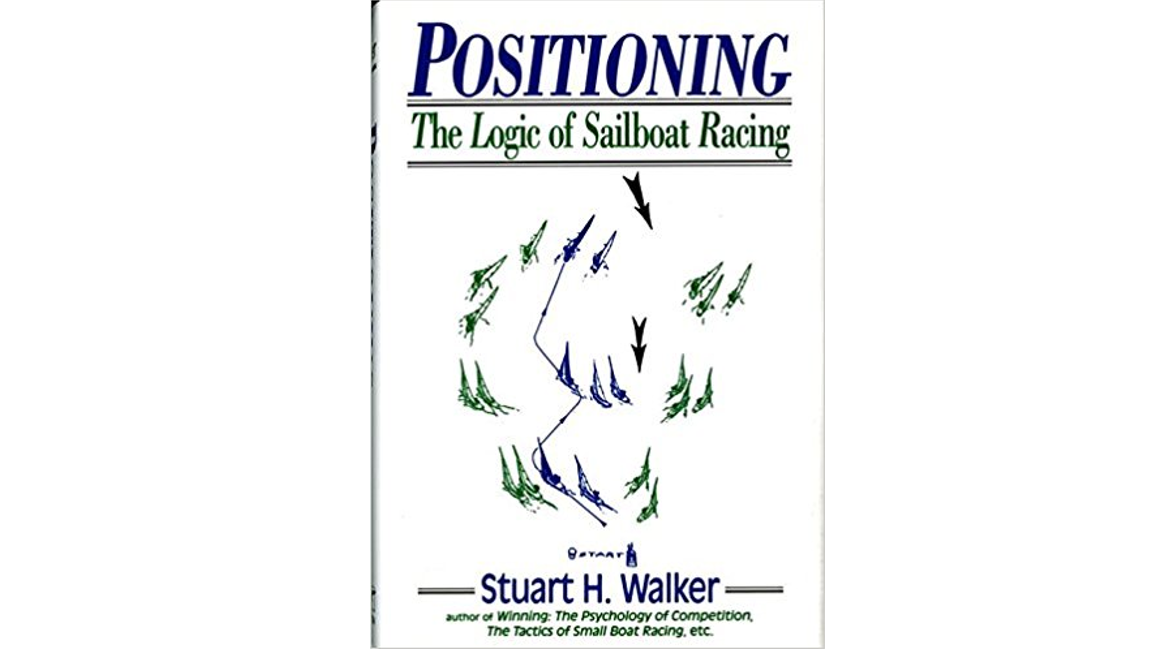
Racing Strategy Choices: Positioning by Stuart Walker – SailZing Book Review
Leave a comment cancel reply.
You must be logged in to post a comment.
This site uses Akismet to reduce spam. Learn how your comment data is processed .

Can Sailboats Go Against The Wind? Here’s How!
- Post Written By: Boater Jer
- Published: July 7, 2022
- Updated: July 8, 2022

Disclaimer: You might notice that we recommend products in some articles. We may earn a commission for referring you if you click the link and buy a product.
We only recommend products we’ve tried/tested/own (that’s why you won’t find thousands of affiliate links on my site). If you have experience with one of the products we’ve mentioned, please share your experiences in the comments at the end.
Can sailboats go against the wind? Let’s find out! There is a saying that you can’t change the direction of the wind and would have to adjust your sail; how true of it. One cannot alter the wind’s current by will or any other method; that is why one should adjust their sail accordingly.
Generally, no sailboat driven by the force of the wind can travel against it per se, but there is a loophole, a mathematical conjecture that allows you to travel against the wind at an angle.
Can Sailboats Go Against The Wind?
With exemplary mathematical prowess, one may be able to maneuver a sailboat against the current of the wind. Downwind sail is more straightforward and hassle-free as the wind is by your side; as for the upwind sail, it is not only challenging but requires a lot of practice and patience to get right.
You must know a thing or two about sailing upwind if, by any chance, you encounter a storm or strong currents of wind that won’t allow you to get to the shore. Learning the sailing techniques against the wind will come in handy.
Mechanism Of Action Going Against The Wind
A sailboat can go against the wind at a 45-degree angle on either side. In the upwind movement, the push becomes available due to the airfoil like the shape of an airplane’s wing adopted by the sailboat, which allows the heavy air or air with more significant pressure to blow on the upper of the foil than on the downward side. It propels the boat against the wind at a perpendicular angle.
The pressure difference on the foil’s upper and lower sides compels the boat to move against the wind’s speed. Although there is no way for the sailboat to go against the wind, the sail is possible at each angle corresponding to the wind’s opposition in perpendicular directions. To go in the wind direction, you must sail as close to the wind as possible, as boats are close-hauled. ( source )
A much more appropriate method that will allow you to stay consistent in sailing speed is the movement at each perpendicular side of the wind for a while before changing to the other side and continuing sailing; many refer to it as tacking. There should be consistent repetition in shifting the action of the side until the boat reaches its desired destination.
A sailboat’s possible direction will depend on the water’s resistance and the force of the wind. This proportionate effect of the current and water propers the craft perpendicular to the wind. Two things are helping a sailboat make sail, i.e., the sail wing that corresponds to the sail in the wind and the keel below water and is responsible for sail below it. The keel takes the strong wind’s force, which compels it to move at a perpendicular angle, thus making the sailboat go perpendicular. ( source )
The sailboat does extract energy from wind by slowing its speed concerning the water. Then this energy is used to drag and then accelerate the boat in a forward direction perpendicular to the wind’s direction.
Tacking Explained
If you want to sail against the wind, you have two dedicated motions that you can probably consider, such as rowing with your hands or using a motorboat or engine to propel further. But if the wind’s speed is too much, you will only be stuck in the middle, traveling nowhere due to the applied resistance.
Tacking is a sophisticated yet straightforward process in which the vessel which wants to travel in the direction of the opposing wind turns its bow towards the wind. The wind current will alter from one side to another, allowing the sailboat to move into the opposed wind direction.
But with tacking, there is a minimal twist: you will continue to change the side of the sailboat in direction with the wind, which is perpendicular to both the left and right side, as it might not hold for too long on the same side. It is a zig-zag motion, but it does allow you to move perpendicular to the opposing wind, provided you continue to change your direction towards each side of the blowing wind. ( source )
Beating
The continuous zig-zag fashion during the tacking maneuver is known as beating, which allows you to move perpendicular to the direction of the wind. Beating involves sailing at one perpendicular side of the current, tacking to get to the other side, and continuing sailing in the same fashion.
The possible angles for the sailboat to move along the wind are 35 to 45 degrees. When a boat is tacking, it moves upwind and across the wind.
How Can Tacking Be Performed?
Tacking might involve more than two people working on the same ship, but it will only be one person or a set of two to get things done for the sailboat. The following method for tacking is for the watercraft with a jib. ( source )
- It would help if you prepared the jib sheets before you start to turn. The jib you are currently using must be released when performing the tack, and you need to bring the other in as the jib crosses over to the other side. You need to ensure that all the crew members understand the mechanism and are ready to work in harmony.
- You need to put two or more members in charge of changing the jib sheet when switching sides with the opposing wind, and it will depend on the size of the sailboat and the number of people available. The helm or the skipper will decide the appropriate time to tack.
- The helm would call the ready about, which would initiate the sequence of turning the jib sheets around, involving the loosening of one sheet to take the turn and the tightening of the other to remain steady with the pressure of the wind.
- When the hem calls “lee-oh,” it is time to turn the boat towards the wind, and when the headsail starts to flap, the crew on the working sheet will then let go of the sheet from the other winch.
- It is how the boat continues to tack, allowing the crew members to continue the crisscross surfing in the opposed direction of the wind.

How To Make Tacking Work? Here Are Simple Tips:
Tacking might not be difficult for experienced surfers as they already know how to control the sheet and coordinate, but it can be a nuisance for beginners. That is why it is essential to understand a few rules before you begin to take away from how you are supposed to.
Be Consistent
If you don’t want your boat to get caught in the irons when trying to tack, you must maintain a consistent speed through and through. It means that you must keep on with the wind speed. If you don’t, your boat might stall or stop entirely due to the heavy resistance proposed by the opposing wind. You will have to wait for the watercraft to catch speed once again before you try tacking in such a scenario. Keep your boat at a steady pace close to the blowing wind before tacking to the other side to avoid the stall.
Don’t Steer Too Sharply
Steering your boat too sharply or moving it far away from the intended turn is another problem you must consider while trying to tack. Suppose you are on the other way, trying to work your way upwind. In that case, it is essential to continue with the close hauling that involves only turning your boat at a propagated time interval while not jetting too much force to stop it from moving too far away.
Avoid Sheets From Getting Tangled
Given the wind’s strong resistance, your jib sheets might get tangled up, and you would have to untangle them. To stop it from happening, you need to close all the foredeck hatches and apply some tension or pressure onto the jib sheets before and after the tacking. Clear off any item or element on the deck that might get these jib sheets tangled, thus ruining your tack.
The boat’s sailing relies on the wind that pushes on its sails and then gets deflected. Due to this deflection, the ship steers forward and perpendicular to the wind. Always keep an angle of tacking to 30-45, and you will do just fine. Once you tack one or two times, you will understand the mechanism in detail, allowing you to go against the wind when time dictates.
- Latest Articles
- Article Sources
- Crab Island by Pontoon: A Fun Watery Boating Guide Destination in 2024
- Upgrade Your Boating Experience: Adding a Third Pontoon Made Easy!
- How Long Does It Take A Canoe To Go… (Canoe Calculator Here)
- In-Depth Review of the Pelican Sentinel 100X Fishing Kayak: Pros, Cons, and Performance
- How To Put A Kayak In The Water – The Ultimate Guide For New Kayakers
- The University of New South Wales, “ The Physics Of Sailing ”, Sydney, Australia
- Paul Luisi, “ How To Sail Against The Wind? ”, Deepsailing
- Daniel Wade, “ How To Sail Against The Wind? ”, Life of Sailing
www.paneraireplica.in
Share this post with your friends.
- Tags: boat maneuvering , sailboat , sailing
Subscribe to our Newsletter
Join us in our love for all things water. And Adventure.

Do Flat Bottom Boats Have Titles?
Have you ever wondered if Flat Bottom Boats have titles? It’s a perfectly valid question, and essential to know if you plan on purchasing a flat bottom boat or already own one. Or maybe you have a different kind of boat and are wondering about the need for a title? A title is a document

Is Paddleboarding Hard?
Is paddleboarding hard? Some might think so, but it is easier than you think. Paddleboarding is not a new sport. In the day, Hawaiian kings used these boards to travel short distances in water. Balancing on a paddleboard for an extended period is tricky, unlike plain surfing, where you only stay on top of the

Bass Boats Vs. Bowriders (A Guide For New Buyers)
Bass Boats Vs. Bowriders (A Guide For New Buyers) – A Boating Guide Buyer’s Guide Report for 2023. Are you curious to know the difference between bass and bowriders boats? While the two types of boats look similar in some ways, they are best suited for different purposes. Bass boats are specifically designed for bass

Are Bass Boats Good For Shallow Water?
As fishermen, we know the importance of being able to navigate your boat in shallow waters. After all, the shallows will present a lot of opportunities to make a nice catch. But it’s essential to know the limitations of your boat. If you get too engrossed in fighting the fish, you can quickly bring the vessel too close to the shore.

Better Boating At Night & How To Survive The Darkness
Have you ever been watching a horror movie and everything gets really quiet all of a sudden? Something like: “Angela slowly walked down the hallway on the second floor of the old Victorian farmhouse. The candle in hand was flickering, teasing to go out as the wood creaked and hawed under her stocking feet. The

Aquila Catamaran (Everything You Need To Know)
Aquila Catamaran (Everything You Need To Know) A catamaran is a double-hulled watercraft driven by an engine or sails. The boat provides much more stability than other like-sized vessels due to its broad beam. As a result, catamarans are a continuous choice among liveaboards. It allows lovers to develop a living space while enjoying cruising.

Boat Information By Type
© 2023 Boating.Guide, A Hyperwave Media Group Ltd. Publication.
Privacy Overview
- Yachts for Sale
- Sales Report 2024
- FAQ – Luxury Crewed Yacht Charters
- FAQ – Bareboat charters
- FAQ – Sell your Boat
- FAQ – Buying a Yacht
- How Much does it Cost to Charter a Luxury Yacht?
- All Blog Posts and News
- Yachting for beginners
- Indian Ocean
- Mediterranean
- Sales & New build
- Motor Yacht
- Event & News

How to Sail Upwind (Against the Wind)?
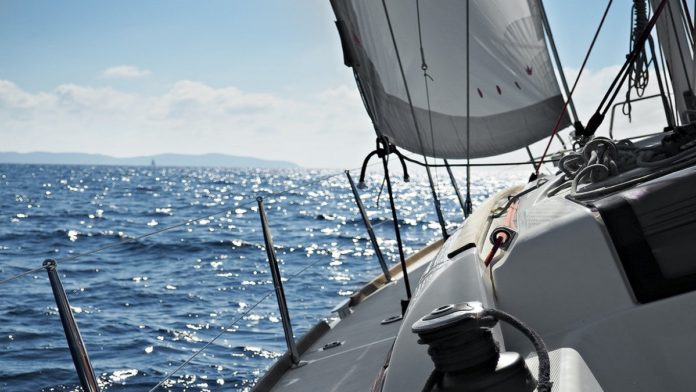
Sailing upwind is perhaps one of the most misunderstood aspect of sailing for most beginners.
The wind, this invisible force, personified and divinized in mythology and religion, has been harnessed throughout human history, but going against it is somehow harder to grasp intellectually than it actually is.
Not surprisingly, one of the first sailing fundamentals you learn when you are new to this world is therefore upwind sailing .
What does this mean? How does a yacht sail upwind? Read on and you will understand this obscure concept.
What is upwind sailing?
Let’s start with a simple and short definition: upwind is when going against the wind.
However, you do not directly go against the wind. That is physically impossible, as you may have already guessed.
“Sailing upwind” means sailing as close to the direction the wind is blowing from as possible. In a word, about 45 degrees away, left or right, from the apparent wind’s direction. You are not going against the exact direction of the wind, but you can move forward against the wind without directly facing it.
What happens if you cross this imaginary line steering the boat closer into the direction of the wind? The sails start to flap around and the boat slows down.
As an old sea-dogs once said: “flapping sail, unhappy sail!” Or something like that.
The main differences between sailing upwind and downwind
While sailing upwind means going against the wind, sailing downwind is going with the wind. It is simply the opposite.
Obviously, sailing downwind is much easier than sailing upwind. If the sailing concept of upwind and downwind is still obscure to you, try with a bicycle and you should quickly understand.
Another important difference involves how the boat is steered and the sails trimmed when going downwind or upwind.
Going upwind, one generally pulls the sails all the way in and then uses them as a guide to steer the boat. When sailing downwind, one usually aims the boat straight to the desired course, and then uses this heading as a guide for how to trim the sails. Upwind sails work like airplane wings. They are trimmed to give lift. Downwind, the air is behind the sails, and they drive the boat by filling and pulling it.
Let’s have a look at how sailing upwind is actually performed while sailing.
Tacking: the main upwind sailing tactic
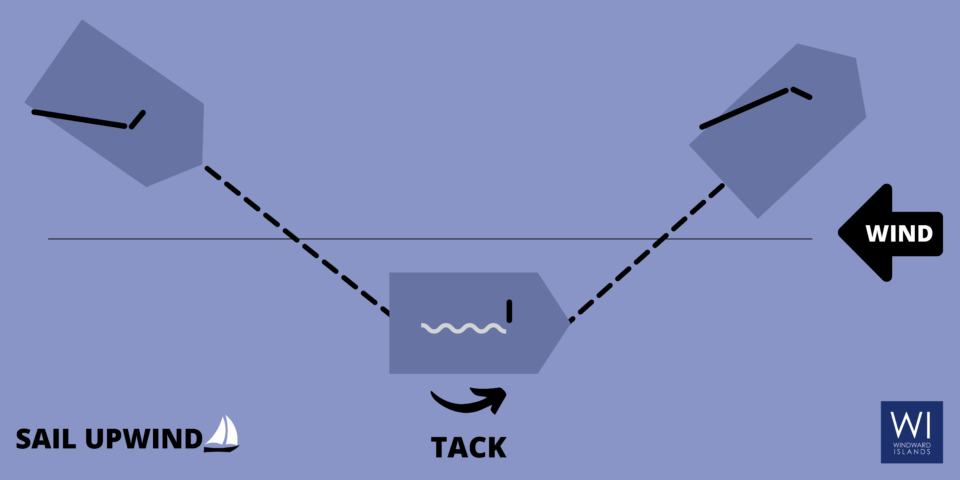
As we have seen above, sailing upwind means sailing towards the general wind direction but not directly into the wind; the sails would flutter and the boat would stop. Instead, sailors use a zigzag motion with moving the bow of the boat, left and right, through the wind in order to make headway. This tactic is called “ tacking ”.
This sounds a very simple thing to do but, in fact, it is tough to be good at. This requires some cooperation from the crew and commands will keep everyone working together. Tacking is teamwork and strength lies in numbers!
Let’s continue with the essential vocabulary mastery. A series of tacking moves, in a zig-zag pattern, is called beating . The opposite manoeuvre to tacking is called jibing . A jibe consists in turning the stern of the boat through the wind so that the wind changes from one side of the boat to the other side. It allows sailing upwind in the desired direction.
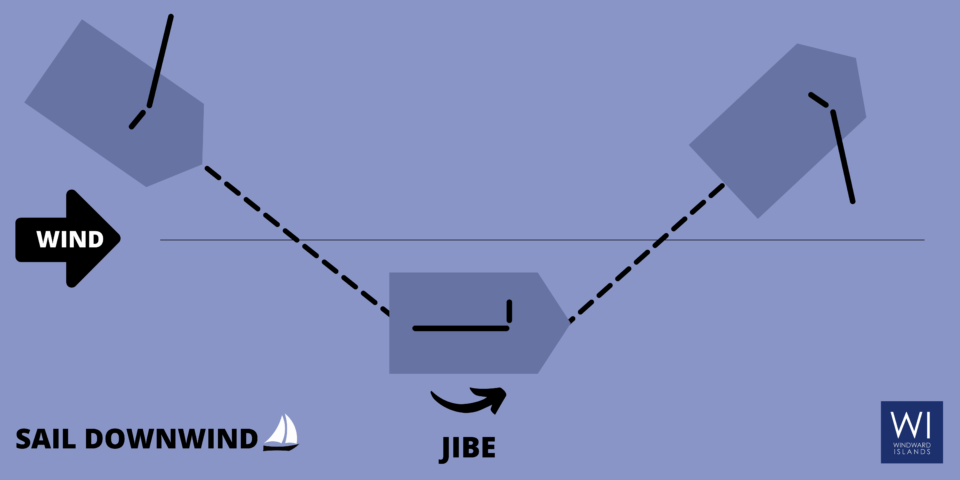
When facing the wind and its various caprices, the art of sailing is real choreography!
How to tack a sailing yacht to sail upwind (against the wind)
Let’s now get to the heart of the matter: the technical aspect of tacking a sailing yacht to sail upwind.
First things first
A good communication and a coordinated team are a must when tacking a sailing boat. To follow, the different steps of the process but before a brief glossary of the key terms.
Port and starboard refer to the left and right side of the vessel, not the observer.
Port Tack : port tack is when the wind is blowing from the port side (left) of the vessel.
Starboard Tack : a boat is on a starboard tack if the wind is coming over the starboard (right) side of boat with sails on port (left) side.
Jib Sheets : ropes and lines to trim or “sheet” the jib.
Working sheet: jib sheets that are actively trimming the jib. They are tight on to the clue and pull out and trim the jib sail.
Lazy sheet : jib sheets ropes that are unused momentarily.
Main sheet : Rope that is attached to the boom and is used to control the mainsail.
How to tack a sailboat properly in 10 Steps
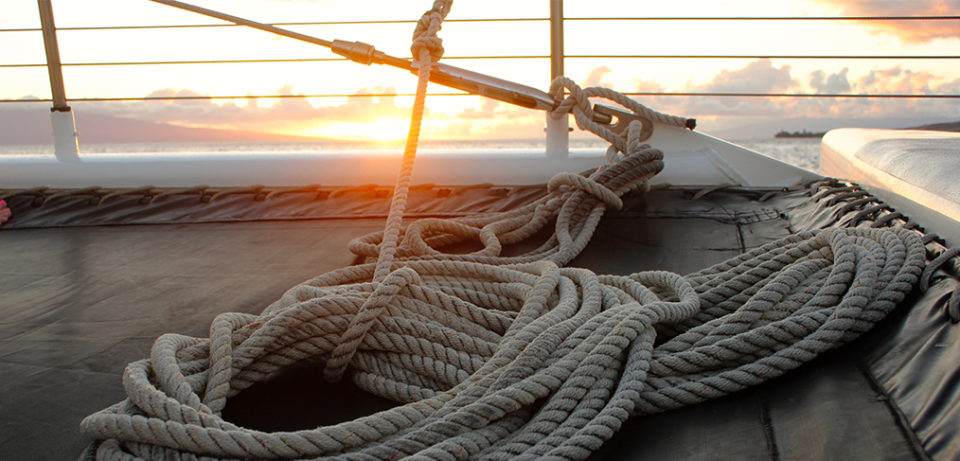
1- The skipper makes sure that the new course is clear.
2- If that is the case, he shouts “ Ready about ” to the crew members to be ready. The perfect translation of “ Ready about ” would be ” before I throw the helm over, are you ready to let go of the old jib sheet, trim in the new and move to the other side? ».
2- He now waits for them to prepare the sheets and lines for managing the sails.
4- In the meantime, the skipper estimates the lay line, that is to say where the boat is going to be pointing after the tack. When sailing upwind the lay line is generally 90 degrees to your left or right from where you stand now. This step is essential.
5- When the skipper hears “ Ready ” or “ All clear ” from the crew, he responds “ helm to lee ” to notify the crew that he is about to start the tacking manoeuvre by turning the steering either to portside or starboard side. When the wind starts blowing the jib to the lazy-sheet, it is the time to stop turning.
6- Then, with calling Lee-Ho or Hard-a-Lee , the skipper announces he is turning the boat towards the wind. The vessel is tacking. As the headsail starts to flap, the crew on the working sheet eases and releases the sheet from the winch.
7-At this stage the wind will have switched sides and is now blowing to the other side of the sails. This is the time when the crew moves to the other side of the sailboat. This point is crucial for the balance of the vessel.
8- The boat continues to turn through wind and the jib blows across to the new side, flapping a little as it goes.
9- This is the good time for the crew on winch to pull in the new working sheet and start pulling in the line on the lazy sheet (now being working sheet) on the other side. The main sheet needs to be tightened in the centre of the boat.
10- The sailboat starts to pick up speed at about 90 degrees off from the original course. The skipper keeps the tiller in the middle. The crew starts to trim and adjust the sail. The tack has been successfully performed!
Read also : New Lagoon 51 Catamaran: The Perfect Combination of Modernity and Sustainability

Tacking to sail upwind with a monohull vs tacking with a multihull
The operations of sailing a multihull and a monohull are basically the same. Almost.
One of the main differences is actually in tacking, so in sailing upwind.
A monohull, much easier to manoeuvre, will tack quickly and is faster to respond to the helm than a multihull.
Conversely, tacking with a multihull can be quite challenging. Because of its lighter weight, wider beam and windage, the multihull will suddendly slow whereas the tacking requires a sufficient speed not to lose too much forward momentum.
Therefore, turning through the wind will be more hesitant than on a ballasted monohull, which carries its momentum through the wind.
Tacking with a monohull vs tacking with a multihull: a clear advantage for monohull!
That’s it, you know everything there is to know about sailing upwind. If you are unsure about how to sail against the wind, you can always charter a yacht with an experienced crew or skipper and see how it’s done pratically.
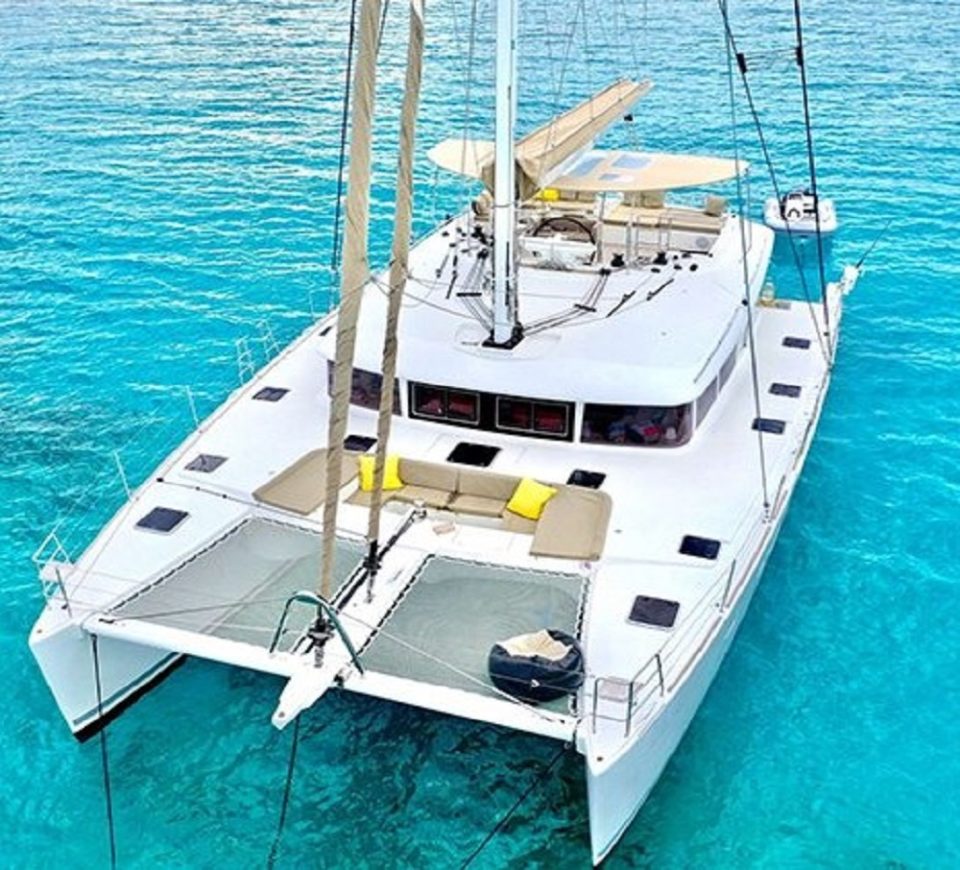
RELATED ARTICLES MORE FROM AUTHOR
Luxury crewed yacht charters – frequently asked questions, luxury yachts for charter perfectly suited for 10 guests, skipper’s job and responsibilities: what you should know.
- Testimonials
- Privacy Policy
The Difference Between Tacking And Jibing (Gybing)
7 real reasons why you should own a sailboat, how to set a sailboat anchor in 5 steps, what do you do when there is no wind.

When I first started out, I remember going through my very first tacks and jibes. The skipper would call out “Ready About!” and I will admit, I was not ready at all. I watched and listened as more seasoned sailors around me rapidly released ropes free of winches, while others wrapped ropes around other winches. Ropes were sent flying off the side, and other ropes were hauled in with ferocity, almost desperation. The boat would heel from one side to the other uncomfortably and I lost my balance regularly. My tacking and jibing knowledge was “baptism by fire”, and I had to learn quick. I found that actually taking part in the process of tacking and jibing sealed my understanding of these two processes. On that trip, I became one of the well-oiled-machine-crew as we tacked and jibed our way up and down the channel. It was awesome!
I hope to break down these concepts in this guide so that you too can get a jumpstart on understanding the difference between tacking and jibing. If you understand the principles upfront, your actual hands on experience will be so much easier.
What is the difference between a tacking and a jibing? Tacking is how you head upwind , pointing as high into the wind as possible, to keep the sails full. A jibe is conducted when you are heading downwind . Both involve the processes of turning the boat to change course when the current direction of travel is no longer possible or safe.
But wait…..How can a sailboat go against the wind?
Sailing Against the Wind
In the explanation that follows, I will be assuming the wind is steady and is coming from one direction only.
When heading upwind, a sailboat is said to be on a tack. Now, by upwind I don’t mean directly into the wind. Sailboats need to turn away from the wind by about 45 degrees so the the sails can fill with wind. This is about as high as a sailboat can ‘point’ upwind. The wind will be blowing over one side of the boat, and the other side will not be in the direct wind. The windward side is called the weather rail, the no-wind side is called the lee.
Sailing upwind is possible in the same way flying is possible for an airplane wing. When wind passes by a wing it goes both over the top and under the bottom of the wing. The wing shape is designed so that wind travelling over the wing has to travel further than the same wind going under the wing. This creates lift. You can recreate this by holding the edge of a piece of paper horizontally up to your mouth. Blowing air at the edge across the “top” side of the sheet. From a hanging down position, the paper will lift and flap in the wind you created. The fast wind flowing across the top of the sheet will cause it to lift.
The same thing is happens as a sailboat tacks upwind. The only difference is, the lift of the sails is kept contained by securing the loose ends of the sail to the boat by ropes. These ropes are called sheets.
Just like blowing across the “top” of a horizontal sheet, the wind blows into the forward edge of a sail, creating a wing like shape, and the principles of lift take over. If you’ve ever watched the America’s Cup sailing races, you will notice that the main sail of the racing sailboats is literally a vertical wing.
There is one more key component to sailing upwind, and that is the keel and rudder. Without the keel, the sailboat would be pushed sideways by the oncoming wind. The keel enables the boat to establish a line of travel by not allowing the wind to push the boat sideways. The rudder works with the keel, once the boat is in motion, to establish the direction of that line.
What is Tacking?
Sailboats can’t sail directly into the wind. They can only head up about 30 – 45 degrees off the angle of the wind. From a bird’s eye view, sailboats look like they are zig-zagging their way to their destination when they are tacking. When heading upwind, you will either be on a port tack or a starboard tack. A port tack means the wind is coming over your port (left) side, and a starboard tack is when the wind is over your starboard (right) side. While on a tack, your sails will likely be close hauled. That means that the sails are pulled in as tight (or close) to the boat as possible. When you find that you need to turn the boat, you will need do a tack. This is the only way to “make way” upwind.
In a tack, if you point your course too high upwind, your sails will flap like a flag. Point your course too low, and you may pick up some great speed, but you won’t make any headway upwind. Effective tacking means finding the balance between pointing high, and maintaining speed.
What is Jibing?
Jibing happens when you are heading downwind. It should be thought of as turning the stern across the wind, as opposed to turning the bow across the wind. When you need to jibe the boat, you use the same basic techniques as tacking, only the main and jib sheets are most of the way out.
How to Tack
Tacking is when you change the course of the sailboat by steering the bow across the wind. As the bow is steered across the path of the wind, the sails will fill on the other side, and the boat will heel over the other way. The boat will now be travelling approximately 90 degrees from the last heading.
There are a few things to coordinate in a successful tack. Communication with your crew is very important. As the boat approaches an area that the skipper feels is suitable for a tack, he will call out “Ready About!” The crew then takes position at the winch, ready to let all of the jib sheet go. The skipper will then call out “Coming About!” This is when he/she will steer the bow aggressively across the wind by about 90 degrees. Now is the time to release all of the jib sheet. The jib sail will flap like a flag as the bow crosses the wind. This is the time to haul in tight on the other jib sheet. If you time it right, and with enough practice, a good crew can complete a tack with minimal lost speed.
How to Jibe
Heading downwind, the principles of sailing are a little easier to understand. The sails are filled with wind and are pushed by it. This is called running, and it is a direct line of travel with the direction of the wind. A sailboat that is running with the wind (or Wing-on-Wing) will have the main on one side of the boat, and the jib on the other. Running requires the jib and main sheets to be let out nearly all the way. This allows the boom to move out and away from the cockpit, about 90 degrees. The same thing happens with the jib sail. Letting the jib sheet out allows the sail to catch the wind at about 90 degrees. When the boat course needs to change, the boat is steered in such a way as for the stern to cross the wind. The wind will fill the backside of one of the sails as the boat turns. This can cause the boom to swing quite rapidly from one side of the boat to the other. This is a real danger to your crew if they are not prepared. Being hit by the boom could be deadly.
If the boom remains in place, the jib will be the sail to backwind and need to be reset. The jib sheet will need to be released from the winch it was on, and hauled in on the other winch, just a bit.
Running requires a great deal of attention to the wind and to the position of the sails. It is not easy to keep both the main and jib sail full of wind. Accidental jibing happens all the time. Many skippers prefer the broad reach as a way to keep under control a little better. Broad reaching is at times faster than running. It is also a way to let your guard down a bit and relax while making way downwind.
Broad reaching is different than running, in that both of the sails will be on the same side of the boat. It is not a direct line of travel with the wind, but looks more like a zig zag pattern. Jibing while broad reaching involves the same process as tacking, however the stern of the boat crosses the wind, as opposed to the bow.
Pingback: Sailing for Beginners: 7 Essential Sailing Tips - Sailboat Zone
Thank You, Your explanation as to the differences between tacking and jibing are crystal clear as well as edifying. I’ve seen a great many try and get these somewhat simple principals across, but none quite so eloquently as your explanation. Keep up the good work. If in the future I become confounded, I will seek out your advice on whatever subject is puzzling me
Much appreciated clarification. I’ve been on a few sails on a trimaran and while I repeatedly hear these terms, I get confused by their subtle differences in meaning.
Thanks for helping me understand these concepts!
Pingback: Common Sailing Terms You Should Know - A Nation of Moms
Leave a Comment Cancel reply
If you are a human, do not fill in this field.
This site uses Akismet to reduce spam. Learn how your comment data is processed .
How to Heave To a Sailboat
- Snowboarding
- Scuba Diving & Snorkeling
Heaving to is a technique for stopping the boat almost completely with the sails still up. The boat maintains a steady position relative to wind and waves, in contrast to "lying ahull," in which sails are dropped and the boat is allowed to drift any which way, usually leading to an uncomfortable and perhaps dangerous boat position. A boat lying ahull is likely to turn the beam onto the waves and may capsize.
An Essential Sailing Skill
Heaving to is an essential sailing skill every sailor should learn. With this simple technique, you can stop the boat in a controlled manner without having to stay at the helm. It can be a valuable skill for managing a storm because it allows you to "lock" the boat at a safe angle to wind and waves and go below to ride it out. Some sailors like to heave to simply to calm the boat for lunch. Singlehanders who do not have an autopilot find it a valuable skill if they need to leave the helm for any reason.
Steps to Heave To
The theory of heaving to is to use the mainsail and headsail, usually the jib, to work against each other to balance the boat at an angle to the wind. The jib is backwinded and attempts to turn the boat away from the wind, while the mainsail and rudder attempt to turn the boat into the wind. With these forces balanced, the boat holds a steady position.
Here are the simple steps for heaving to:
- Bring the boat into a close-hauled point of sail with both the mainsail and jib trimmed in tight.
- Tack across the wind without releasing the jib sheet, unlike in normal tacking .
- Once on the new tack, the wind in the backed jib will attempt to blow the bow further away from the wind. Turn the rudder to keep the boat toward the wind on your new tack. The force of the mainsail will try to move the boat toward the wind just as the force in the jib tries to push it away.
- As needed, adjust the mainsheet and the rudder position until the forces balance out and the boat stays steady relative to the wind, often roughly 60 degrees off the wind.
- Lash the tiller or wheel to keep the rudder in this position. The boat should stay heaved to in this position unless thrown off by a sudden gust or a big wave, very slowly drifting away from the wind.
These basic steps are easy to learn, but not every boat acts the same. More modern boats require some adjustment and practice in order to heave to.
Heaving-To Adjustments for Different Sailboats
Various factors affect how a sailboat heaves to. For example:
- The longer the sailboat's keel , the easier it will be to heave to. A boat with a fin keel, in contrast, can spin easily and will need to be more carefully balanced.
- The larger the jib or headsail, the harder it will be to heave to because the larger force of the wind against the backed sail can easily blow the boat completely off the wind regardless of the driving force of the mainsail.
- The smaller the mainsail in relation to the jib, the harder it will be to heave to, for the same reason. A boat with a reefed mainsail and a large jib that has not been furled , for example, may be impossible to heave to.
Heave To in Your Own Boat in Six Steps
- Start by practicing on a day with a good, steady wind, but not too much wind for the first time.
- First, follow the basic steps to see how your boat performs.
- After tacking and letting the jib be backwinded, observe how your boat behaves.
- If the bow keeps turning farther from the wind, put the rudder hard over to turn back toward the wind with the mainsail sheeted in tight. If nothing you can do keeps the boat from being blown completely back around, into a gybe situation , then you will have to reduce the size of your jib in order to heave to. With a furling jib, bring in enough of the sail so that the bow is not blown completely off when the sail is back winded. You can also try easing the jib sheet a little so that the sail is slightly less backed. With a hanked-on jib, try with a smaller working jib or a storm jib. After all, in a storm situation, you would not want a large jib up anyway.
- If the power of the mainsail threatens to tack the boat again against the backwinded jib, then let out some mainsheet. Keep the rudder over as if trying to turn into the wind and tack, but with the mainsail out further, as in the illustration above. The boat should not have enough forward drive to be able to tack against the jib and will settle into the heaved-to balance.
- Once you've found the best method to heave to in your particular boat, practice. Be sure to practice on a day with a good strong wind when you might have to reef the mainsail down and use a smaller jib or furl your jib. The same principles hold true in storm winds but you may need further adjustments.
Heaving to is a valuable technique for coping with many different situations. Sailors are often surprised by how calm the boat becomes when the forces are balanced, and a calm steady boat might be essential for coping with a medical emergency, a storm or any number of other reasons.
- When to Adjust Sailboat Sails for Stronger Winds
- Simple Reefing System for Sailors
- Marine Navigation
- Step-by-Step Instructions for Tying a Sailor's Bowline Knot
- Using AIS on Your Sailboat
- Know Your Boat: Terms for Location, Position, and Direction
- How to Tow a Dinghy Behind a Sailboat
- The Basics of Navigation
- How to Rig a Preventer Line
- How to Anchor a Sailboat
- How to Raise the Mainsail
- Raster versus Vector Charts in Nautical Use
- The Sunfish: A Perfect Lake or Urban Sailboat
- How to Use Roller Furling
- How to Gybe a Sailboat
- Choosing a Centerboard or Fixed Keel Sailboat
- How it works
- Homework answers

Answer to Question #130674 in Physics for Darlington Zoe
"a_x=3.2\\cdot\\sin45\u00b0-4.5\\cdot\\sin50\u00b0+2.6\\cdot\\sin45\u00b0=0.654(km)"
"a_y=3.2\\cdot\\cos45\u00b0+4.5\\cdot\\cos50\u00b0+2.6\\cdot\\cos45\u00b0=6.994(km)"
"a=\\sqrt{0.654^2+6.994^2}=7.025(km)" Answer
Need a fast expert's response?
and get a quick answer at the best price
for any assignment or question with DETAILED EXPLANATIONS !
Leave a comment
Ask your question, related questions.
- 1. An airplane flies from Freetown to Monrovia and back to Freetown. Is the displacement zero in the re
- 2. A bee flies 12 m north, 8 meters west, and then 4 meters south. What is the bee’s total distance a
- 3. A person jogging on a track at a speed of 5 m/s for 12s will cover what distance
- 4. What are significant figures?what are the rules for determining significant figures in the final res
- 5. The total energy consumption of a country is of the order 108 J. What area of solar collector would
- 6. What are scalars and what are vectors? Explain in detail along with difference. Also explain two dif
- 7. an elephant dragging a tree trunk along a horizontal surface by means of an attached rope makes an a
- Programming
- Engineering

Who Can Help Me with My Assignment
There are three certainties in this world: Death, Taxes and Homework Assignments. No matter where you study, and no matter…

How to Finish Assignments When You Can’t
Crunch time is coming, deadlines need to be met, essays need to be submitted, and tests should be studied for.…

How to Effectively Study for a Math Test
Numbers and figures are an essential part of our world, necessary for almost everything we do every day. As important…
- AROUND THE SAILING WORLD
- BOAT OF THE YEAR
- Email Newsletters
- America’s Cup
- St. Petersburg
- Caribbean Championship
- Boating Safety
- Ultimate Boating Giveaway

Shocks and Drops At Louis Vuitton Cup Start
- By Dave Reed
- August 29, 2024

The collective groans from the coach boat of the New York YC’s American Magic were likely audible across the Med as they were starting their first race of the Louis Vuitton Cup Challenger Series Round Robins. But those moans were likely nowhere near those of Emirates Team New Zealand’s shore team when its multimillion dollar Cup yacht came crashing down into its cradle during a lift-out crane failure after racing. We’ll get to that, but first the match ups.
While the American stars on Patriot lacked luster on the opening day, it was the Frenchmen of Orient Express Racing Team, widely panned as the squad most likely to be first sent packing from the Challenger fleet, that shone brightest. The scrappy new team won the first race of the Round Robin Series in their match against Alinghi Red Bull Racing and give Luna Rossa Prada Pirelli a good battle in the last match of the day.
Dogged by mis-timed starts in the Louis Vuitton Preliminary Series last week, the French had their time-and-distance woes sorted once the first entry after several light-wind postponements. With the wind hovering below 10 knots, the helms and trimmers of Orient Express kept the boat in flight as they loosely engaged with Alinghi Red Bull Racing in the start box.
Alinghi led back inside 1 minute and OE went for the hook, pushed Alinghi further down the line toward the pin and once they knew they were compromised, they tacked away with a split start. The French went left and Alinghi took the right. By the time they came back together for the first cross, the French had a tasty 150-meter lead that they would not relinquish.
Eyebrows were raised across the Challenger field as those who’d been giving the French lip service as a dark-horse threat were now singing their praises.

“In this breeze, when you fall behind, it’s hard to catch up,” said Alinghi Red Bull Racing’s trimmer Nicolas Rolaz. “The boat needs a lot of adjustments, and we also need to keep our eyes out to look for the best pressure and best wind. Obviously, our strategy wasn’t the best today. We believed the right side was pretty strong, and our forecast supported that. In the end, we got smashed by the left. The guys we’re up against also know how to read the wind and how to defend, so it was almost over from the beginning.”
Juan Vila, the America’s Cup Hall of Famer and top-shelf strategist for the Swiss team said after racing, “When you’re behind, it’s difficult to catch up, but overall, I think the guys did a great job of minimizing the distance and taking every opportunity, every shift, to catch up.”
Simply catching up doesn’t earn a point in the series, however, and so the elimination table was set after the first course, with the French sitting on 1 point and Alinghi none.
The next pairing was Luna Rossa Prada Pirelli and Emirates Team New Zealand, the defender who wrote the rules allowing them to play with the challenger fleet in these early round-robin races. The defender’s points essentially don’t count, so this match was a chance for the Italians to once again check in with their AC36 rivals and hone their craft.
Again, in the marginal foiling conditions, the pre-start sparring was safe as the Italian’s pushed the Kiwis toward the pin end. Both boats crossed the line dead even on time and speed, with plenty of space between them as they sprinted to the left boundary. The Kiwis were first to tack and the Italians went to the boundary. The first cross was a sight to behold for Jimmy Spithill, watching from his starboard cockpit as they crossed with 70-meter lead.
Keeping their distance with an easy cover, Luna Rossa had the first gate by 11 seconds and the two teams split down the run. There was barely 40 meters between them on the first downwind cross and 5 seconds through the leeward gate. The Italians split right, the Kiwis left, and when they met the middle minutes later the Italians had them by 80 meters.
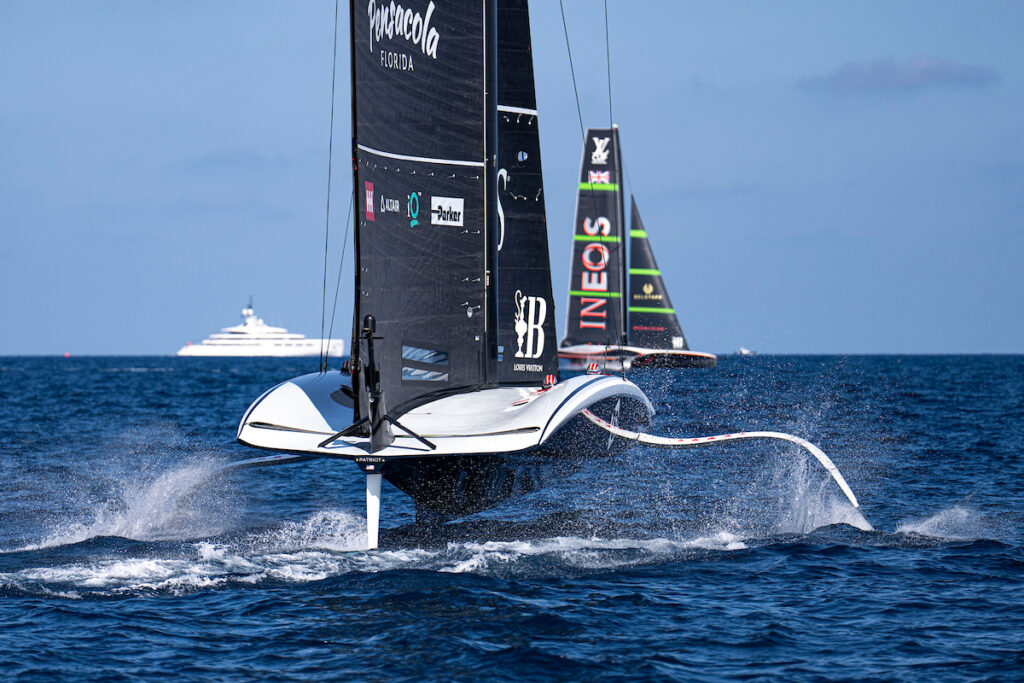
At the next meeting in the middle of the course, the racing finally got spicy. The Italians stuck a leebow tack a fraction too late, Burling called for a “high mode,” the New Zealand boat rocked to weather and bit into one lane higher, turning a bad position into a strong one in a matter of seconds.
Virtually side by side, they tacked simultaneously and Italian port helmsman Francesco Bruni could be heard warning about the Kiwi’s “high-mode after the tack.” Burling confirmed as much with his call for the same move, and just at the wrong time, the Italian boat’s rudder lost its grip, the boat got a bit of a wobble and in an instant the Kiwi’s stern was visible over the Italian’s front hood.
Once again, the Kiwis rarely lose once ahead, and once again, the defenders cruised across the finish with another win in hand.
“We stuck with them when we needed to and took a few opportunities to split and get back into the race,” ETNZ trimmer Andy Maloney told AC Media. “Then, on that final tack, they tacked in a position that we thought we could just live with on their hip long enough to hold them to the layline and then did a pretty nice tack out of there as well and just managed to squeeze them off it.”
One point for the Italians and they were on the board, one step away from the elimination cliff.
The meeting between American Magic and INEOS Britannia followed with the wind slightly up from the morning, and this should have been a telling match for a British team that struggled to find its footing and pace in the Preliminary Regatta. It had been a rough start to the regatta for helmsman Ben Ainslie who’d also been reportedly mugged at knifepoint in Barcelona over the weekend and robbed of his Rolex.
He wouldn’t have needed the timepiece in the team’s start against American Magic. The Americans were off the foil before they even entered the start box from the starboard entry. “Go ugly early,” is the saying.
With Patriot unable to start properly or get on the foil, INEOS was off and running with a gift of a point. Over the course of the six-leg race the Americans were able to take significant bites out of the British lead, but again, close doesn’t count—no win, no points.
“American Magic had a few issues at the start so we had a big old gap there and we didn’t feel like we sailed a particularly great race in terms of either defending the lead or finding the right balance and the groove in the boat,” said Ainslie to AC Media after racing. “So, we spent a bit of time after racing just trying to figure that out, particularly on the maneuvers which we know are so key in these conditions. I think it’s a positive result but there’s plenty to work on.”
From the American camp, Port helmsman Paul Goodison attributed the team’s race woes to a wrong jib selection before the race start. “When we came across to the starboard end of the line for the start, we saw 5 to 6 knots wind speed and it was too light to maneuver,” he told AC Media. “So, we shot ourselves in the foot there but after that it was impressive how we pulled ourselves back together and kept on chasing, chasing, chasing.
“We are bitterly disappointed. We wanted a win today and we are going to have to take a good hard look at what went wrong in the start box. But there is plenty positive to take away from how we sailed the boat and how we managed to keep clawing it back in conditions that were hard to come back in.”
The fourth and final race of the day had the Italians back on the racecourse with the French for their second races of the day, and once again the green crew of Orient Racing Express held their own in the pre-start, but the Italian’s are sailing at a much higher level, and Spithill and Bruni bossed them from the first cross onward.
Thus, the day ended with Kiwis atop the leaderboard, but soon after, word spread quickly around Barcelona’s Port Vell that the crane handling the team’s AC75 Taihoro had a malfunction and dropped the boat into its cradle from a height of several meters. A team statement issued late Thursday, August 29, said they would not be racing until “a full plan for the repair of Taihoro is in place.”
Observers in the area noted damage to one of the boat’s foils, as well possible damage to the boat’s bow area.
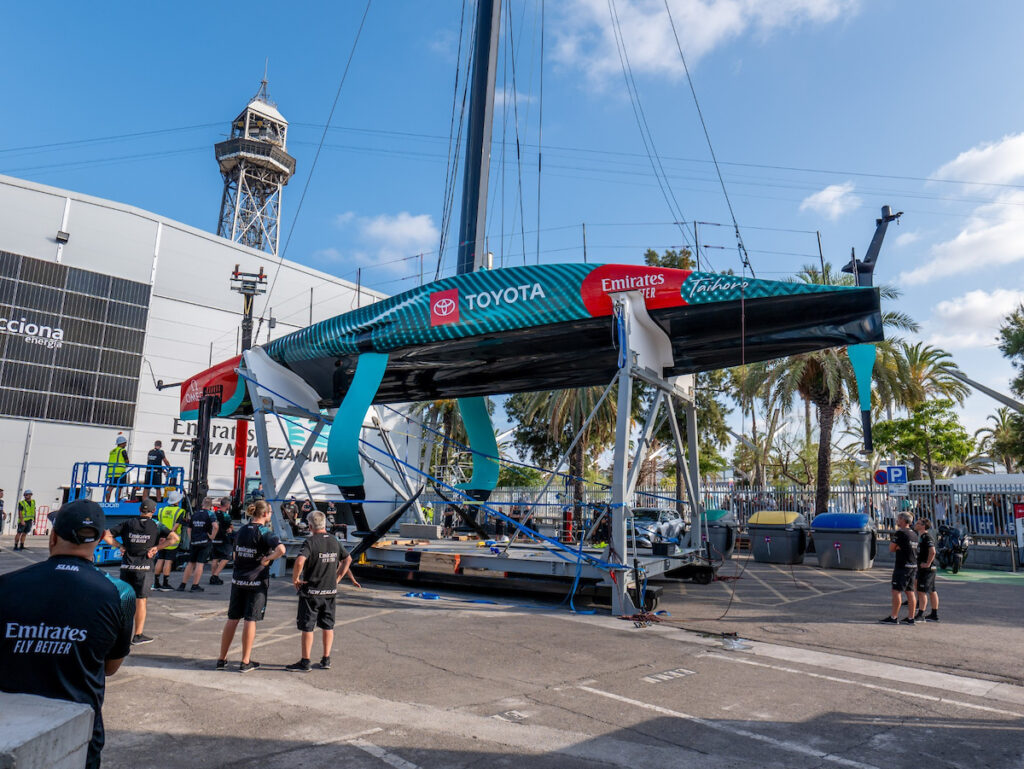
“Clearly this is a setback for the team at such an important time of the campaign,” said CEO Grant Dalton. “These are the moments that can define an America’s Cup campaign, and we have an amazing group of dedicated and talented people who will be working around the clock on getting the boat repaired. We will not be sailing tomorrow at least, and will provide further updates on the outlook in due course.”
With the Kiwis out, INEOS and Orient Express lose opportunities to race tomorrow, leaving the remaining two races: starting the day with American Magic and Alinghi and Luna Rossa against American Magic, which will have the American tapping their entire cyclor team.
- More: America's Cup , America's Cup 37
- More Racing

One and Done on Drifter Day of Cup Challenger Series

Rivals Flush American Magic Facemask Rule Enquiry

The Reemergence of Jimmy Spithill

Hound Still Running With the Pack

Comfort Rules with Mustang’s Minimalist Buoyancy Aid

Mistakes And Misfires On the Final Day of Cup’s Preliminary Regatta

Emirates Team New Zealand Remain the Bullies of Barcelona

- Digital Edition
- Customer Service
- Privacy Policy
- Terms of Use
- Cruising World
- Sailing World
- Salt Water Sportsman
- Sport Fishing
- Wakeboarding

Self-Tacking Staysail: not just for heavy weather
The Mental Game Is Hard, Sailing Is Easy
Sailing in pirate territory (midnight boarding), best sailing apps, sailing when we never thought we could (our full sail plan).
EMIRATES TEAM NEW ZEALAND QUALIFY FOR PRELIMINARY REGATTA FINAL AFTER WIN OVER ALINGHI RED BULL RACING ON DAY 3.
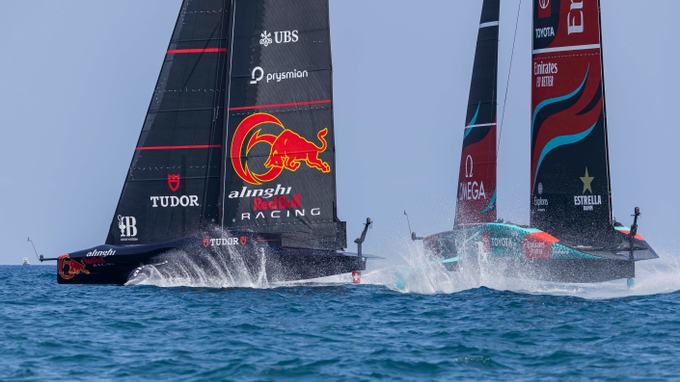
Emirates Team New Zealand had just one race on the penultimate day of the Louis Vuitton Preliminary Regatta against Alinghi Red Bull Racing - a win would set the kiwis up to comfortably qualify for the top two final race on Sunday that will decide the preliminary regatta winner.
In a lighter 7-10 breeze it was a click down on the racing conditions seen so far in the preliminary regatta but a comfortable range for Taihoro and the Emirates Team New Zealand sailing team to line up against the Swiss challengers.
AMERICA’ S CUP RACE REPORT
Emirates Team New Zealand (Port Entry) vs. Alinghi Red Bull Racing
The overnight leaders of the Louis Vuitton Preliminary Regatta, Emirates Team New Zealand are looking for a clean race here against Alinghi Red Bull Racing and it’s Nathan Outteridge steering from the port pod who brings ‘Taihoro’ into the pre-start box a couple of seconds late and heads deep into the box accepting the trail of the Swiss. At the gybe, the Kiwis go first but then bear away under the Swiss before getting trapped high. However, it’s the first time we’ve seen a split-tack start as the Kiwis tack away and take the starboard end, starting on port and heading over to the right. Alinghi Red Bull Racing make a near-perfect start at the port end and head to the left of the course but as both boats come back together in the middle of the course, it’s Emirates Team New Zealand who have the advantage and begin bouncing the Swiss left.
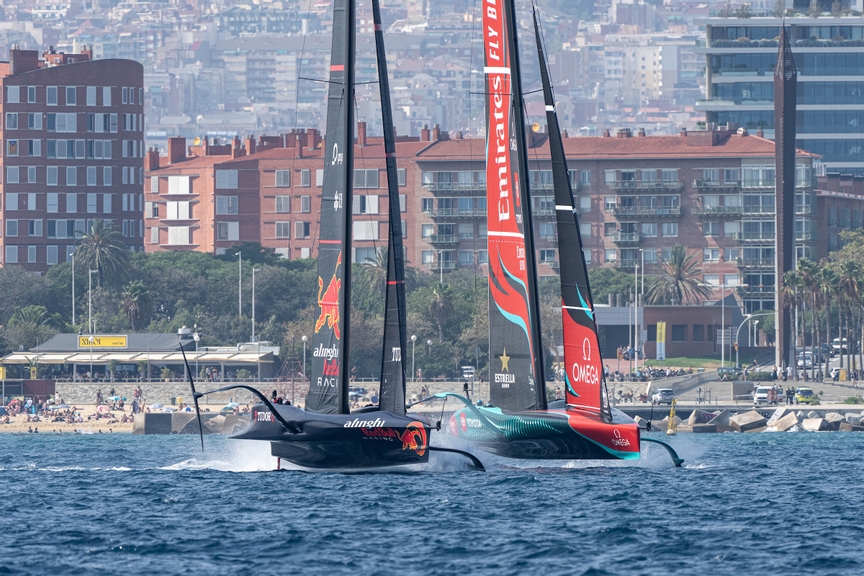
The tacking duel up the middle of the course was revealing with the Kiwis gaining through every tack and into the final quarter of the beat their lead had stretched in excess of 100 metres. Frustrating for the Swiss, the tight cover was sending dirty air down the course and at the first windward mark it was Emirates Team New Zealand with a 12 second lead.
Alinghi Red Bull Racing are the first to gybe, covered loosely by the Kiwis and both boats head down the course on a long port gybe as the lead stretched to in excess of 400 metres. At the first leeward mark, the Kiwis set up to take the starboard marker and headed upwind to the left with a smooth one-board round-up. The Swiss followed suit, showing good boat-handling, taking the port marker and headed to the right boundary. Emirates Team New Zealand came back from the left to cover on a nice pressure build and then slapped the cover on the Swiss ruthlessly.

With the wind dropping, the Race Committee reduced the length of the legs to just 1.45 miles and the pressure came on the Flight Controllers through the manoeuvres to keep the boat flying. Smoothness through the tacks is something of a hallmark for the Kiwis and they showed great exit speeds so that by the second windward mark, they rounded the port marker at almost 38 knots but with an increased lead of some 45 seconds.
No mistakes on the Kiwi boat, keeping the power-on and showing some lovely windward heel to get the maximum out of a dying breeze whilst still flying upwind in excess of 32 knots and keeping tacks to a minimum. At the final windward mark, Emirates Team New Zealand opted to take the starboard marker in order to play the left side of the run and headed off to the left boundary with a lead now extended out to one minute and 15 seconds. Just two gybes down the final leg and the victory went to the Kiwis with a winning delta of one minute 15 seconds. Impressive sailing in very tricky conditions from Emirates Team New Zealand.
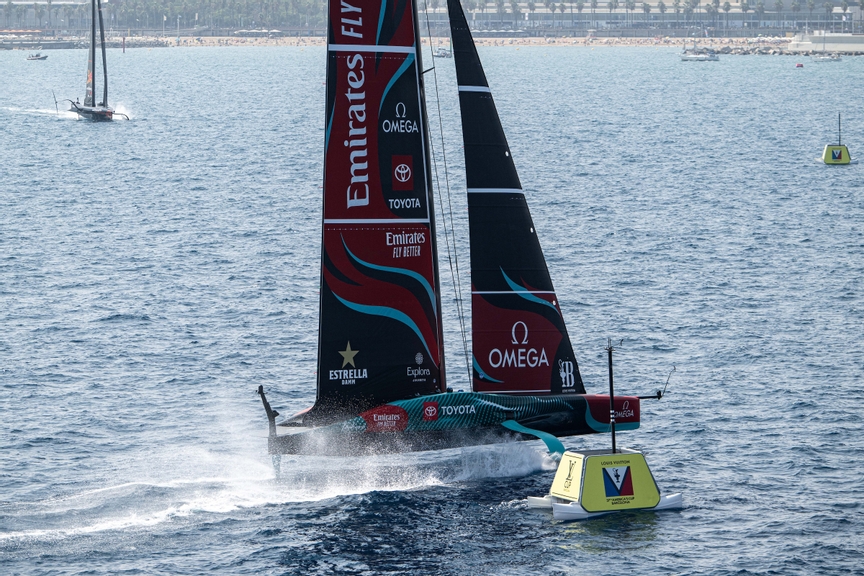
Emirates Team New Zealand beat Alinghi Red Bull Racing (75 seconds)
The win, confirming Emirates Team New Zealand a place in the Preliminary Regatta final tomorrow, was again shaped in the pre start. Skipper Peter Burling explains, “We really wanted the right of the start line and then when Alinghi Red Bull Racing jumped us early we thought we would take on the split tack start. We haven't seen any split starts at this event so it's good to get one under our belt and it seemed to work out alright.
Talking about Taihoro and the performance of the boat overall, Burling said:
“We are really happy with our boat across the range, I think it a lot of it is about actually understanding how to sail the boat or how to use your equipment well and we're still learning a lot about that. But we are really happy in those conditions. We haven’t actually seen it that light like that for a little while so it was a little bit of just switching back into that mode up the first beat and I'm really happy with the way we did.”
Looking ahead to tomorrow, to complete the round robin Emirates Team New Zealand have a much anticipated match up against American Magic who will be coming off a loss to Orient Express Racing Team due to rudder damage in the pre start today.
Then the 4 day regatta will come down the final winner takes all match race to decide the winner of the Louis Vuitton Preliminary Regatta.
Tune into Stuff, Three, ThreeNow and www.americascup.com for all races live, replays and highlights every race day.

More From Forbes
Tensions and hostility against america’s cup sailing competition ‘for the rich’ in barcelona.
- Share to Facebook
- Share to Twitter
- Share to Linkedin
The Red Bull Alinghi AC75 boat sails pass The American Magic AC75 'Patriot' boat during a training ... [+] session in Barcelona. Photo by David Ramos
Resentment against the effects of massive tourism has been brewing for years in Barcelona, and that sentiment has reached new heights this summer precisely as the America’s Cup , the world’s premier sailing competition, starts and becomes the latest target of protests and criticism.
Protesters are blasting the oldest sporting race in the world that runs from August 22 to October 27 as ‘elitist and opaque’, claiming that it’s “just for rich people,” driving up prices for locals and putting the Spanish city under more pressure.
The Platform Against the America’s Cup, created last year to fight “against an event that will generate mass tourism and is already causing the massive diversion of housing to seasonal rentals,” as stated on their site, has said that new protests against the event are being organized as six teams compete to claim the 37th victory of the yacht race .
“A lot of people involved in the race have taken up long-term rents on apartments in the city center and pushed up prices for local people,” Martí Cuso of the Platform warned. “There will be protests coming in the first week of September.”
New Password Hacking Warning For Gmail, Facebook And Amazon Users
Trump vs. harris 2024 polls: harris leads trump in latest post-dnc surveys, today’s nyt mini crossword clues and answers for wednesday, august 28th.
Poster by The Platform Against the America’s Cup in Barcelona
According to the daily La Vanguardia of Barcelona, “the America's Cup 2024 disguises the agony of beach clubs in Barcelona and all Catalonia.”
The article explains how, paradoxically, the celebration in Barcelona of the oldest regatta in the world coincides with the demolition of local nautical clubs. “This global event hides the anguish of Catalan sailing clubs threatened by a rigid enforcement of the State Coastal Law.”
“The great legacy that the Cup will bring for Barcelona is the recovery of the coast,” Barcelona’s mayor told El Periodico newspaper.
Las Ramblas pedestrian street with crowds of tourists
Looking for “Quality Tourism”....for the rich
From the official side, The America’s Cup — the ultimate sporting competition for the super-rich — is, in fact, an effort by city officials to attract “quality, rather than quantity” tourism.
The yacht competition is sponsored by the luxury fashion house Louis Vuitton , which in late May had already organized a star-studded fashion show in the Park Güell, one of Barcelona’s most popular tourist attractions, designed by the architect Antoni Gaudí, that caused serious clashes between residents protesting the closure of the park for the glitzy event and baton-wielding police charging at protesters.
A model parades during a Louis Vuitton fashion show at Park Guell on May 24, 2024, in Barcelona, ... [+] planned as part of the 37th America's Cup. Photo By Lorena Sopena
Since then, anger has been growing over the fact that the city is being overrun by tourists and glitzy international events to the detriment of local life.
“Local people say they have been bombarded with calls from estate agents and speculators wanting to buy their homes to cash in on the event, which they say is pushing up rents” the Guardian writes.
Two models of AC75 sailboats during the first day of the last preliminary race of the America's Cup, ... [+] in the Port of Barcelona, on 22 August, 2024. Photo By Alberto Paredes
Displaced by the crowds
Much of the local population has already been driven out of the areas of Barcelona most affected by mass tourism and campaigners fighting for more stringent controls argue that “rather than attracting a ‘better’, high-spending type of tourist, events such as the America’s Cup simply bring more people to a city already struggling to cope with the mass of visitors.”
Those who live near hot spots in the city are frustrated with daily life where, as reported in the New York Times , they feel “displaced by the crowds; pollution along the waterfront where massive cruise ships dock; and everywhere, it seems, an apparent disregard for local culture.”
Jaume Collboni, the socialist mayor of Barcelona, has said that the contest will bring €1.2 billion in revenue for the city, and create jobs. Critics, on the other hand, say that the potential income from the lavish competition will be enjoyed by few as the tournament itself is followed mostly by the elites.
“This is not like the Olympics, where people are interested in the sport,” Cuso told the web news site i . “This is just for rich people who can afford to go and see the yachts on their own boats at sea.”
He went further to explain that the yachts are sponsored by luxury brands that want to use Barcelona to promote their products.
America's Cup trophy
Tensions and hostility rising
Tensions over tourism that finally boiled over into outright hostility has triggered splashy headlines globally, such as the incident last month when some 3,000 residents took to the streets to protest against tourism , some squirting visitors on the city’s famed boulevard Las Ramblas with water guns.
In 2023, 12 million tourists visited Barcelona, a city of 1.6 million residents, making it the favorite destination in Spain. This year, tourism officials ex[ect at least 13 million visitors.
“Their impact includes skyrocketing housing prices, dirty beaches, crowded thoroughfares and the transformation of historic neighborhoods into what locals refer to as “theme parks,” The New York Times writes.
Barcelona is the second Spanish city to host the competition. Valencia hosted two consecutive editions in 2007 and 2010.
Security reinforcements
As for the multi-million pound America’s Cup, a major security operation has been launched around the event and competition areas with more than 650 police deployed in land, six boats patrolling the sea and helicopters flying above Barcelona. The Civil Guard has also deployed divers to reinforce security at sea.
Following years of technological innovation and hundreds of millions of euros of investment from super-rich backers, the Emirates Team New Zealand will be defending the title against challenges by boats from Italy, Switzerland, France, the U.K. and the U.S.
At the round-robin stage, which will last until September 8, each challenger crew races each other twice, with the top four progressing to the semi-finals. Those Challengers of Record will face-off against the reigning champions in a series of races in October.
Most of the teams have had established bases for training in Port Vell, the city’s old port, since last year.
The America’s Cup was first staged on the Isle of Wight in 1851 and is claimed to be the oldest international sporting event in the world. It was last held in 2021 in Auckland, New Zealand, and was won by the hosts.
- Editorial Standards
- Reprints & Permissions
Join The Conversation
One Community. Many Voices. Create a free account to share your thoughts.
Forbes Community Guidelines
Our community is about connecting people through open and thoughtful conversations. We want our readers to share their views and exchange ideas and facts in a safe space.
In order to do so, please follow the posting rules in our site's Terms of Service. We've summarized some of those key rules below. Simply put, keep it civil.
Your post will be rejected if we notice that it seems to contain:
- False or intentionally out-of-context or misleading information
- Insults, profanity, incoherent, obscene or inflammatory language or threats of any kind
- Attacks on the identity of other commenters or the article's author
- Content that otherwise violates our site's terms.
User accounts will be blocked if we notice or believe that users are engaged in:
- Continuous attempts to re-post comments that have been previously moderated/rejected
- Racist, sexist, homophobic or other discriminatory comments
- Attempts or tactics that put the site security at risk
- Actions that otherwise violate our site's terms.
So, how can you be a power user?
- Stay on topic and share your insights
- Feel free to be clear and thoughtful to get your point across
- ‘Like’ or ‘Dislike’ to show your point of view.
- Protect your community.
- Use the report tool to alert us when someone breaks the rules.
Thanks for reading our community guidelines. Please read the full list of posting rules found in our site's Terms of Service.
The superyacht tragedy will likely spark legal drama
- A deadly superyacht sinking off the coast of Italy during a storm will likely spark legal drama, experts said.
- Maritime legal experts say lawsuits are likely, but negligence would need to be established.
- "I would not be optimistic about the chances for any claims," one expert said.

The operator of the superyacht that sank during a violent storm off the coast of Italy this week is likely to face legal troubles over the tragedy that left UK billionaire tech tycoon Mike Lynch and others dead, according to maritime law experts.
But the success of any potential lawsuit is up for debate.
Three maritime legal experts told Business Insider that the operator and owner behind the now-sunken luxury sailing yacht called the Bayesian should lawyer up in anticipation of possible claims from families of the dead or the survivors themselves.
"There's always the possibility of claims when there's a casualty," said Martin Davies, the director of the Maritime Law Center at Tulane University School of Law in Louisiana. But based on what is currently known about the incident, Davies said it is "unlikely that any claims would succeed."
Michael Sturley, an expert in maritime law and professor at the University of Texas at Austin's School of Law, agreed. "Based on what we know now, I would not be optimistic about the chances for any claims," he said.
However, Sturley noted, "There is still a lot that we don't know."
Bad weather does not automatically absolve a party of liability, but it would be challenging to make a wrongful death or personal injury claim as negligence would need to be established, according to the experts.
"Under English law, they'd have to prove fault and I don't think there's much prospect of anyone proving fault," said Davies.
"Bad weather at sea is not at all unexpected, which is why you can't just simply say bad weather and hope to get off the hook," Davies said. "What seems different about this case is that it came suddenly."
Still, said Oregon-based maritime lawyer Gordon Carey, "It doesn't spell defeat" for a potential legal claim "just because it's a weather event."
Related stories
The yacht was carrying 22, including UK tech tycoon Mike Lynch and a Morgan Stanley exec
The British-registered 184-foot yacht was anchored about a half-mile off the Italian port of Porticello near Palermo, Sicily, and carrying 22 people when a fierce storm hit and quickly sank the vessel just after 4 a.m. on Monday, according to reports.
The body of the yacht's chef, Recaldo Thomas, was found on Monday. Six other passengers — Lynch; his 18-year-old daughter Hannah; Lynch's friend and Morgan Stanley International chairman Jonathan Bloomer; Bloomer's wife, Judy; Lynch's attorney Christopher Morvillo and Morvillo's wife Neda — went missing during the disaster.
Divers on Wednesday found the bodies of Lynch and four of the missing inside the sunken yacht that was around 164 feet below the surface. Sky News reported that Lynch's 18-year-old daughter, Hannah, was unaccounted for.
Lynch's wife, Angela Bacares , was among the 15 people who were rescued in the aftermath of the tragedy. Reports said Lynch had been on the boat celebrating his recent acquittal on fraud charges in the US.
According to the Associated Press , documents show Bacares as the sole owner of Revtom Ltd., the Isle of Man-registered company that the online international maritime database Equasis lists as the owner of the Bayesian.
The Bayesian was being managed by the global yachting company Camper & Nicholsons. In a statement posted to its website, the company said it can "confirm that the vessel encountered severe weather conditions and subsequently sank near Palermo, Italy."
There were a total of 10 crew members and 12 guests on board, it said.
"Our priority is assisting with the ongoing search and providing all necessary support to the rescued passengers and crew," the company said.
It was not immediately clear who the captain and crew of the vessel were employed by. Camper & Nicholsons declined to comment beyond the statement posted online.
The maritime legal experts BI spoke to said that the operator of the Bayesian could potentially face liability claims, depending on the circumstances, if it hired the captain and crew and managed the vessel.
Davies said a boat like the Bayesian is bound to have "all kinds of insurance."
"And so someone may make a claim in the hope of getting some money from the insurance," he said.
English law would likely apply if any claims were made
According to Davies, it is more likely that English law would apply should the family of any of the victims or a survivor try to take legal action since the yacht was a UK-flagged vessel. US law could be applied if jurisdiction could be established, said Davies and others.
Under US law, crew members, not passengers, could potentially make an "unseaworthiness" claim, according to the maritime experts.
"The advantage of unseaworthiness is it's a strict liability claim," said Sturley. "You don't have to prove negligence. For other losses, you'd have to prove negligence."
To make an unseaworthiness claim, Davies explained, "you'd have to argue that there's something about the vessel that makes it unfit to withstand a sudden storm like this."
However, he said, "I find it hard to see there was any unseaworthiness of the vessel here."
Also under US law, the families of the dead could potentially make a legal claim under the Death on the High Seas Act, the experts said.
"People are supposed to take precautions against weather, but you take precautions that are reasonable under the circumstances, and sometimes you have a freak weather event that nobody could see coming, and it would not have been reasonable to have guarded against that," Sturley said.
He added, "Nobody prepares for hurricanes in the Sahara Desert. And if a hurricane happens to hit the Sahara Desert, that doesn't mean that people who didn't guard against it were negligent."
The AP reported that Italian civil protection officials believe that a tornado-like waterspout hit where the yacht was anchored, likely causing it to capsize.
"If it was a water spout, which it appears to be, it's what I would class as like a 'black swan' event," Matthew Schanck, chair of the UK-based Maritime Search and Rescue Council told the AP.
- Main content
Divers find body of Mike Lynch's daughter Hannah, 18, missing after superyacht sank

Italian divers have retrieved the body of Mike Lynch 's 18-year-old daughter, Hannah Lynch, the last person who went missing after the Bayesian , the British tech tycoon's family yacht, sank off the coast of Sicily earlier this week.
The 184-feet-long, U.K.-registered vessel capsized and rapidly sank off the port of Porticello, near Sicily's capital of Palermo, as an unexpected storm swept the area before sunrise on Monday.
Specialist divers discovered Hannah Lynch's body on Friday after five days of scouring the sunken boat, an unnamed senior official with knowledge of the rescue operation told Reuters.
The disaster set off an exhaustive search for six of its 22 passengers, who were unaccounted for after the ship sank. Mike Lynch's body was discovered on Thursday, while the bodies of Jonathan Bloomer, a non-executive chair of Morgan Stanley International, his wife, Judy Bloomer, Clifford Chance attorney Chris Morvillo, who was a U.S. citizen, and his wife, Neda Morvillo, were discovered on Wednesday. The five bodies were all located inside the sunken ship.
Recaldo Thomas, the ship's cook and a citizen of Antigua, was pronounced dead on Monday after his body was found near the ship. Thomas also went by Ricardo, according to media reports .
The bodies will be officially identified and autopsies will be performed in Palermo.
The fire brigade said on Friday the rescue operation was "long and delicate" – the ship sits more than 160 feet underwater, and its inner passageways are narrow, posing a challenge to divers. More than 400 rescuers were involved, including 28 specialist divers, officials said.
Lynch's family said in a statement on Friday the family "is devastated, in shock and is being comforted and supported by family and friends."
"Their thoughts are with everyone affected by the tragedy. They would like to sincerely thank the Italian coastguard, emergency services and all those who helped in the rescue," they wrote.
"Their one request now is that their privacy be respected at this time of unspeakable grief."
Breaking news, in your pocket. Sign up for USA TODAY's Daily Briefing newsletter.
A judicial investigation has been opened into the sinking, which has baffled naval marine experts, who say a boat like the Bayesian , built by Italian high-end yacht manufacturer Perini, should have withstood the storm.
Prosecutors in the nearby town of Termini Imerese have opened an investigation into whether human errors were a factor. Coast Guard officials already have questioned the captain, James Cutfield, and surviving crew members and passengers as part of the investigation.
A maritime legal expert told USA TODAY the disaster could lead to lawsuits and possible criminal charges against Cutfield.
"As far as the charges, it appears that the captain will be investigated for not having due diligence in command of his vessel," said Mitchell Stoller, a maritime expert witness and captain. "He cannot discharge his duties."
Stoller said a captain's general duties include watching local weather reports and preparing for incoming storms. He said ships usually don't remain anchored during a storm so that they can maneuver in turbulent waters − Italian authorities have said the Bayesian was likely anchored before the disaster.
"The general standard of care in this situation is to monitor the weather, exercise caution, have a night watch, have the engine going, ready to maneuver," he said.
Giovanni Costantino, CEO of The Italian Sea Group, which owns Perini, told Reuters the crew made a string of "indescribable, unreasonable errors" in the leadup to the disaster. Design or construction errors did not play a role, he said.
No charges have so far been announced. Prosecutors will hold a news conference on Saturday.
Cutfield did not immediately return a request for comment from USA TODAY sent on Friday to a Facebook profile that appeared to belong to him. It is unclear if Cutfield has retained an attorney.
Complex Salvage Operation
Further inspections of the ship, which officials say is intact and lying on its right side, could give investigators more clues. Authorities may pull it out of the water, but the operation would be expensive and complicated.
Nick Sloane, a South African engineer who led the operation to recover the Costa Concordia, a cruise liner that sank 12 years ago, estimated such an operation could cost up to $16.7 million, in interviews with Italian media on Friday.
Pulling the yacht to the surface could take several days, and would need to be done "very, very slowly," he told daily La Repubblica. The entire operation could take up to eight weeks and would need to be completed by mid-October, he said.
Contributing: Reuters
- Share full article
For more audio journalism and storytelling, download New York Times Audio , a new iOS app available for news subscribers.

- August 30, 2024 • 9:56 Gaza Fighting to Pause for Polio Vaccinations, and Harris’s CNN Interview
- August 29, 2024 • 9:02 Israel Steps Up West Bank Raids, and Trump’s Arlington Incident
- August 28, 2024 • 9:59 Federal Cases Against Trump Revived, and Israeli Forces Raid West Bank
- August 27, 2024 • 10:25 Russia Pounds Wide Swath of Ukraine, and F.T.C. Fights Grocery Merger
- August 26, 2024 • 9:32 Israel and Hezbollah Trade Airstrikes, and U.S. Border Crossings Drop
- August 23, 2024 • 10:19 Harris Makes Her Case, and the New Covid Vaccine
- August 22, 2024 • 11:35 Kennedy Is Expected to Drop Out, and Revised Data Shows Job Market Cracks
- August 21, 2024 • 8:37 The Obamas’ Back-to-Back Speeches, and a Secret U.S. Nuclear Defense Plan
- August 20, 2024 • 9:05 Biden Passes Torch to Harris, and Blinken Pushes for Gaza Cease-Fire
- August 19, 2024 • 9:02 Division at the Democratic Convention, and G.O.P. Efforts to Impeach Joe Biden
- August 16, 2024 • 8:38 Harris’s Strategically Vague Economic Message, and Russians Feel the War
- August 15, 2024 • 9:43 All Eyes on Gaza Cease-Fire Talks, and Kennedy Explores a Cabinet Job
Federal Cases Against Trump Revived, and Israeli Forces Raid West Bank
Plus, a new theory about orca boat attacks., listen to and follow “the headlines” apple podcasts | spotify | amazon music | youtube | iheartradio.
Hosted by Tracy Mumford
Featuring Alan Feuer and Adam Satariano
Produced by Ian Stewart
Edited by Jessica Metzger and Tracy Mumford
On Today’s Episode:
How the Federal Cases Against Trump Came Sputtering Back to Life , by Alan Feuer
First Jan. 6 Rioter to Enter Capitol Gets More Than 4 Years in Prison , by Orlando Mayorquín
Israel’s Military Raids West Bank in Broad Operation, Killing at Least 9 , by Gabby Sobelman and Victoria Kim
Can Tech Executives Be Held Responsible for What Happens on Their Platforms? , by Adam Satariano and Cecilia Kang
Mormon Church Broadens Restrictions for Transgender Members , by Ruth Graham
Scientists Have a New Theory About Why Orcas Are Attacking Boats , by Lynsey Chutel

Tune in, and tell us what you think at [email protected] . For corrections, email [email protected] .
For more audio journalism and storytelling, download the New York Times Audio app — available to Times news subscribers on iOS — and sign up for our weekly newsletter.
Alan Feuer covers extremism and political violence for The Times, focusing on the criminal cases involving the Jan. 6 attack on the Capitol and against former President Donald J. Trump. More about Alan Feuer
Adam Satariano is a technology correspondent for The Times, based in London. More about Adam Satariano
Advertisement
trending now in World News

Billionaire's wife didn't want to leave site of sunken Sicily...

Cruise passengers stranded in Ireland for three months after...

Passenger destroys American Airlines counter with hammer after...

Toronto’s 1st black female police superintendent demoted after...

American archaeologist dies off Norway coast after replica Viking...

4-year-old museum visitor accidentally smashes Bronze Age jar —...

Disturbing details emerge after man pours scalding hot coffee on...

Teen decapitated in vicious shark attack off Jamaica coast: 'He...
Hamas, israel agree to multiple three-day pauses in war to vaccinate kids against polio.
Hamas and the Israeli military both agreed to multiple three-day pauses in the war in Gaza so health officials can vaccinate some 640,000 children against polio, the World Health Organization said Thursday.
The mass vaccination campaign is set to begin on Sunday in central Gaza for three days, with both sides agreeing to a halt in combat in the region until the next phase, said Rik Peeperkorn, the WHO senior official for that region.
The vaccination effort will then move to southern Gaza for another three days, with the final, three-day tour scheduled in the north.

Israeli and Hamas officials agreed to extend the cease-fire in the respective regions for a fourth day, or more, if needed.
“We are ready to cooperate with international organizations to secure this campaign, serving and protecting… Palestinian children in the Gaza Strip,” Hamas official Basem Naim told Reuters.
The vaccination effort comes after the WHO confirmed last week that at least one infant had been paralyzed by the type 2 polio virus — the first case in the Palestinian enclave in 25 years.
Since the war broke out on Oct. 7, Gaza’s polio vaccine coverage dropped to about 80%, with Peeperkorn explaining that at least more than 90% is needed to stop the outbreak from spreading.

The Israeli military’s humanitarian unit, COGAT, said the vaccination campaign will be coordinated with the IDF “as part of the routine humanitarian pauses that will allow the population to reach the medical centers where the vaccinations will be administered.”
Israel had coordinated the entry of about 25,100 vials of the polio vaccine earlier this week through the Kerem Shalom Crossing — more than enough to inoculate 1.25 million people.
Polio, which has been wiped out in most of the world , mostly affects children under five years old, with the virus capable of causing irreversible paralysis and even death.

The highly infectious virus has no cure and can only be prevented by immunization, according to the WHO.
The pause in fighting comes as Israel and Hamas have yet to agree on a proposed cease-fire deal to temporarily halt the fighting across Gaza and free the remaining hostages.
With Post wires

Advertisement

IMAGES
VIDEO
COMMENTS
Tacking is an maneuver used to change the direction of a sailboat by turning the bow (front) of the boat through the wind. This maneuver allows the boat to sail against the wind, also known as sailing upwind or into the wind. Whether you choose to tack to the right or the left, the goal remains the same. However, tacking encompasses more than ...
When sailing, tacking is used to sail against the wind or to change the direction of the boat when sailing at an angle to the wind. The tacking sailing maneuver means a sailboat will sail in a zig-zag direction against the wind rather than sailing at a 90-degree angle windward.
Tacking: Sailing the craft into the wind from the port tack to the starboard tack. Beating to windward on a series of port and starboard tacks, tacking between each at points 1, 2, and 3. Tacking or coming about is a sailing maneuver by which a sailing craft ( sailing vessel, ice boat, or land yacht ), whose next destination is into the wind ...
This tacking process creates a zigzag pattern as the boat sails back and forth, gradually progressing closer to its upwind destination. While it may seem less direct than sailing with the wind, tacking allows sailboats to travel efficiently in any direction, even against the wind.
Tacking You'll use the Tacking maneuver frequently when sailing against the wind, requiring a series of zigzags against the wind direction to reach your destination. The Tacking Process involves teamwork. See below for the steps to follow: 1️⃣ One person sits beside each jib winch.
Tacking and Jibing As we've seen, a sailboat cannot sail directly into the wind. The "no-go" zone covers approximately 45° on either side of the wind, so how does a sailboat move toward a desired point that is located upwind? The answer is by tacking back and forth on a zigzag-like path.
On a sailboat, wind blowing against the boat at an angle inflates the sail, and it forms a similar foil shape, creating a difference in pressure that pushes the sail perpendicular to the wind ...
Short answer tacking vs jibing: Tacking and jibing are sailing maneuvers used to change the direction of a boat. Tacking involves turning the bow through the wind, while jibing involves turning the stern through the wind. These maneuvers are crucial for navigating against wind direction and maximizing efficiency in sailboats.
Simplified Tacking Lines for Better Judgments How's your sense of geometry on the race course? Can you make quick and accurate judgments about laylines, who's ahead, and the direction of the wind? Tacking lines can help. In this post, we discuss the geometry behind tacking lines and suggest how you might adapt a practical version of the concept for small boat sailing.
It propels the boat against the wind at a perpendicular angle. The pressure difference on the foil's upper and lower sides compels the boat to move against the wind's speed. Although there is no way for the sailboat to go against the wind, the sail is possible at each angle corresponding to the wind's opposition in perpendicular directions.
Sailing into the wind is a sailing expression that refers to a sail boat's ability to move forward despite being headed into (or very nearly into) the wind. A sailboat cannot make headway by sailing directly into the wind ( see "Discussion," below); the point of sail into the wind is called "close hauled".
2. What is the physics behind tacking? Tacking is a maneuver that allows a sailboat to change direction while sailing against the wind. It works by using the shape of the sails to deflect the wind and create lift, which propels the boat forward at an angle.
How to tack a sailing yacht to sail upwind (against the wind) Let's now get to the heart of the matter: the technical aspect of tacking a sailing yacht to sail upwind.
What is the difference between a tacking and a jibing? Tacking is how you head upwind, pointing as high into the wind as possible, to keep the sails full. A jibe is conducted when you are heading downwind. Both involve the processes of turning the boat to change course when the current direction of travel is no longer possible or safe.
A sailboat tacking against the wind moves as follows: 3.2 km at 45 ∘ east of north, 4.5 km at 50 ∘ west of north, 2.6 km at 45 ∘ east of north. What is the net displacement for the entire motion?
Here are the simple steps for heaving to: Bring the boat into a close-hauled point of sail with both the mainsail and jib trimmed in tight. Tack across the wind without releasing the jib sheet, unlike in normal tacking. Once on the new tack, the wind in the backed jib will attempt to blow the bow further away from the wind.
52 Solar sails are a great, inexpensive way to move out from the sun, if you're not in a hurry. Ocean going ships are able to tack against the wind, and to move up wind. Could a solar sail gain inbound (towards the sun) momentum by tacking? propulsion orbital-maneuver orbital-mechanics solar-sail Share Improve this question edited Jul 19, 2013 at 10:23 s-m-e 6,461 1 40 72 asked Jul 18, 2013 ...
A sailboat tacking against the wind moves as follows: 3.2 km at 45° east of north, 4.5 km at 50 ° west of north, 2.6 km at 45 ° east of north. What is the net displacement for the entire motion?
A sailboat tracking against the wind moves as follows: 3.2km at 45°east of North, 4.5km at 50°west of North, 2.6km at 45°east of North. What is the net displacement of the entire motion?
The Italians stuck a leebow tack a fraction too late, Burling called for a "high mode," the New Zealand boat rocked to weather and bit into one lane higher, turning a bad position into a ...
Crew Only Basics & How To's Gadgets & Gear Gear Guides Sailing Videos Self-Tacking Staysail: not just for heavy weather ... Previous Post →. Read more. The Mental Game Is Hard, Sailing Is Easy. Sailing In Pirate Territory (midnight boarding) Best Sailing Apps. Sailing When We NEVER Thought We Could (our full sail plan) The Archives; Map; Gear ...
The tacking duel up the middle of the course was revealing with the Kiwis gaining through every tack and into the final quarter of the beat their lead had stretched in excess of 100 metres. Frustrating for the Swiss, the tight cover was sending dirty air down the course and at the first windward mark it was Emirates Team New Zealand with a 12 ...
The Platform Against the America's Cup, created last year to fight "against an event that will generate mass tourism and is already causing the massive diversion of housing to seasonal rentals ...
The boat executive, Mr. Costantino, has argued that the Bayesian was an extremely safe vessel that could list even to 75 degrees without capsizing. His company, the Italian Sea Group, in 2022 ...
The operator of the superyacht that sank during a violent storm off the coast of Italy this week is likely to face legal troubles over the tragedy that left UK billionaire tech tycoon Mike Lynch ...
Italian divers have retrieved the body of Mike Lynch's 18-year-old daughter, Hannah Lynch, the last person who went missing after the Bayesian, the British tech tycoon's family yacht, sank off the ...
Authorities in Italy have opened a manslaughter investigation into the sinking of superyacht, the Bayesian, which killed seven people off the coast of Sicily earlier this week.
Plus, a new theory about orca boat attacks. Alan Feuer covers extremism and political violence for The Times, focusing on the criminal cases involving the Jan. 6 attack on the Capitol and against ...
Russian forces are closing in on a critical logistical hub in eastern Ukraine that is key to sustaining Kyiv's troops in their fight against the invaders, experts have warned.
Hamas and the Israeli military both agreed to multiple three-day pauses in the war in Gaza so health officials can vaccinate some 640,000 children against polio. Primary Menu Sections US News